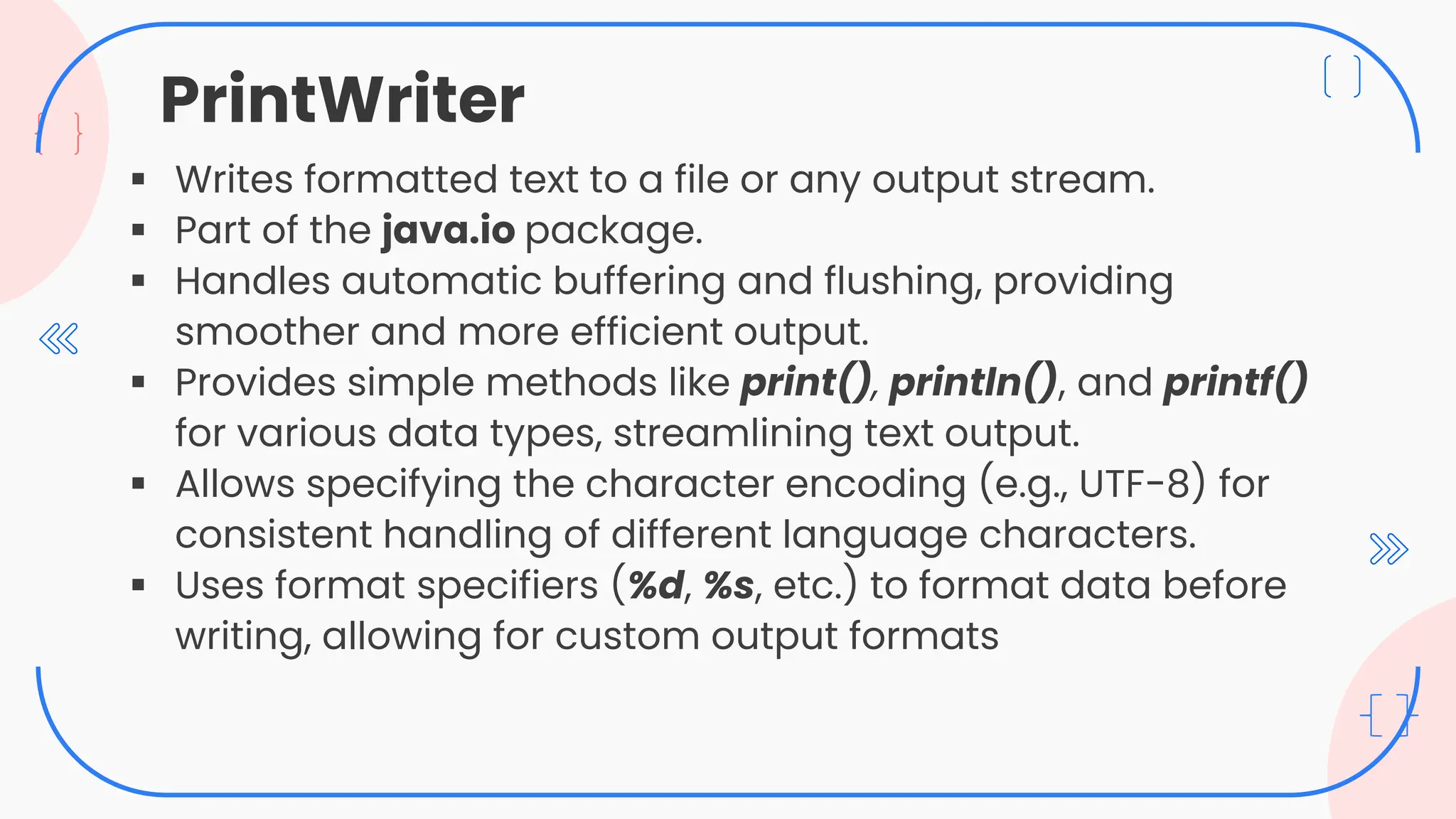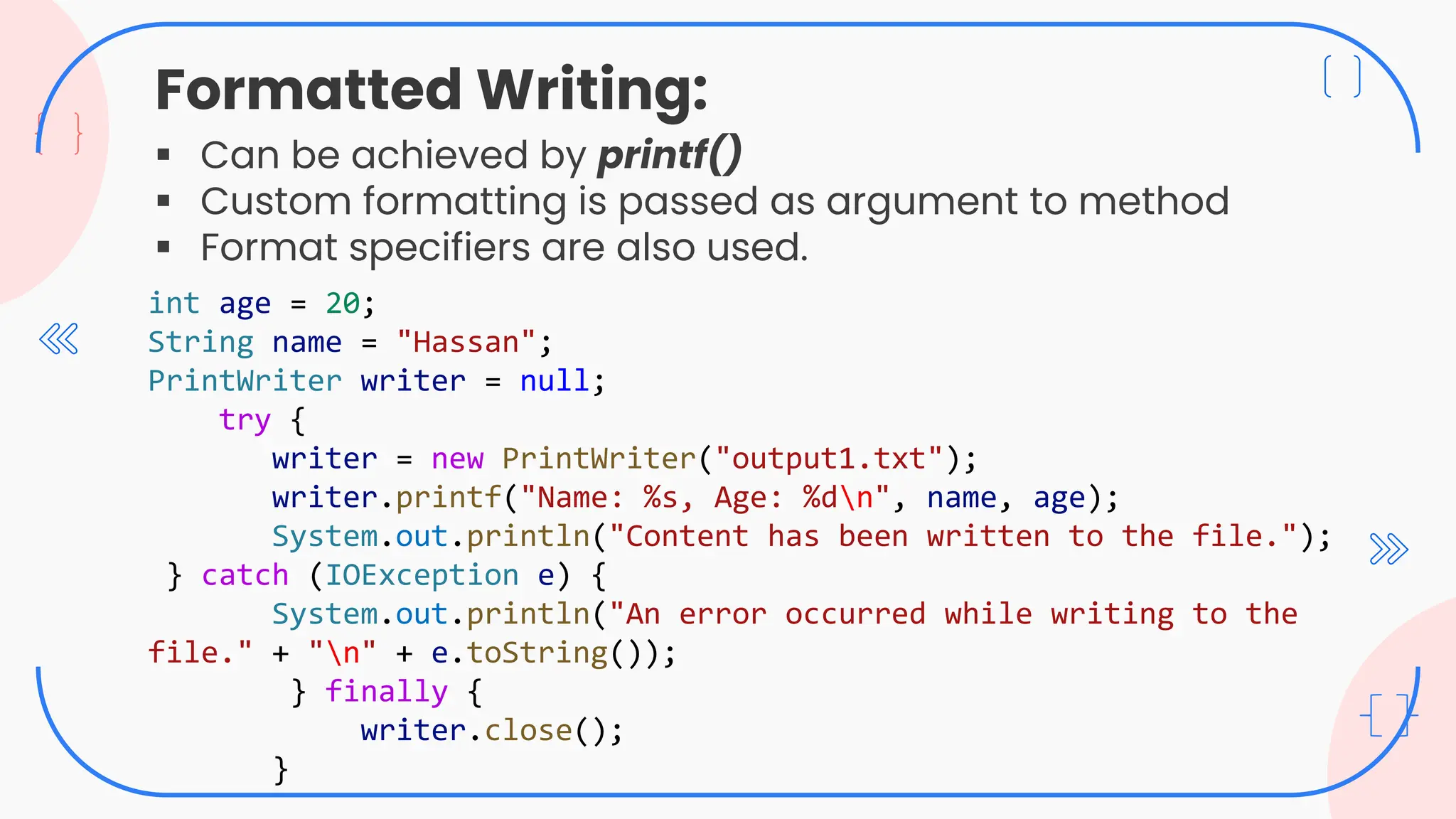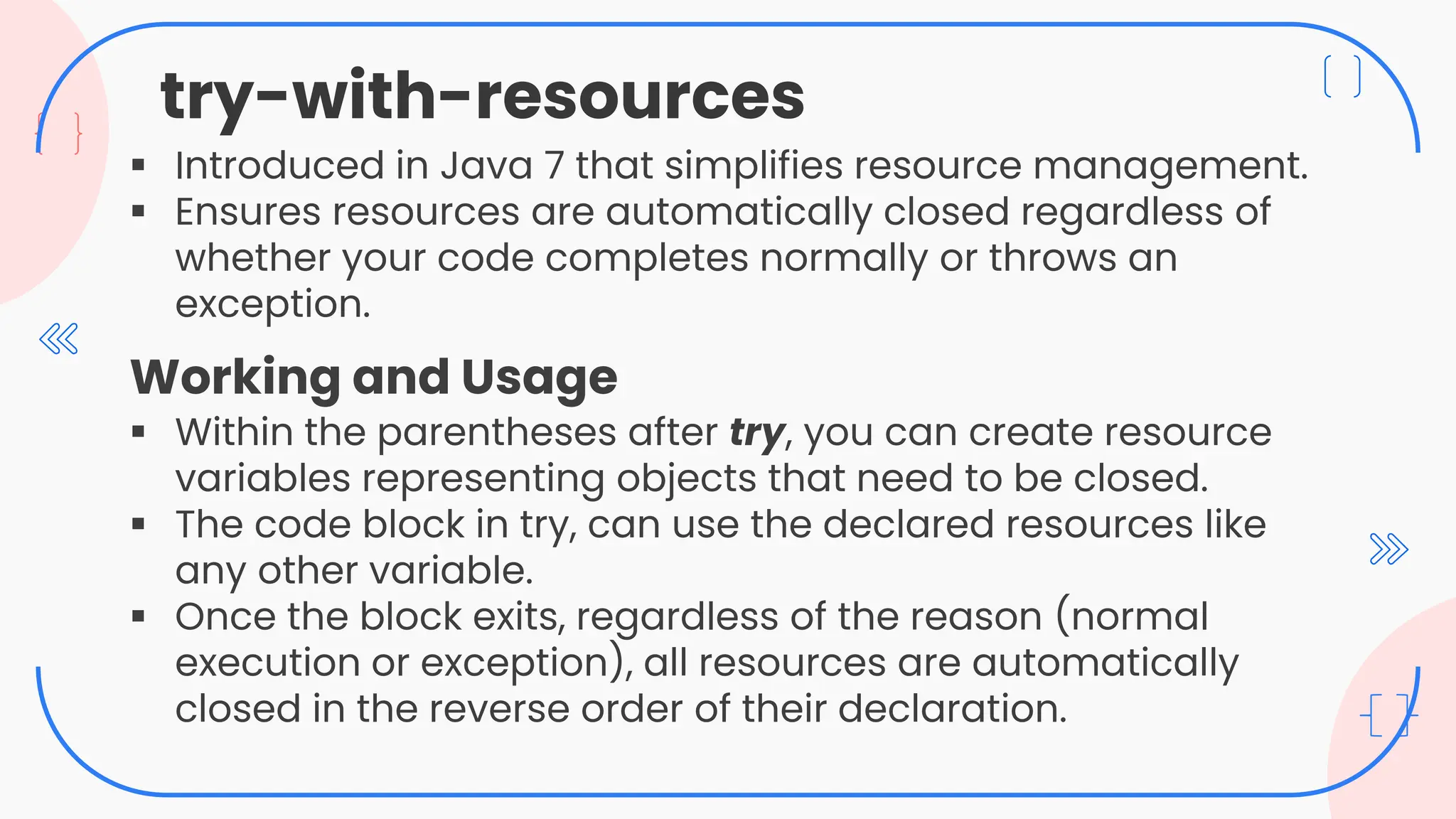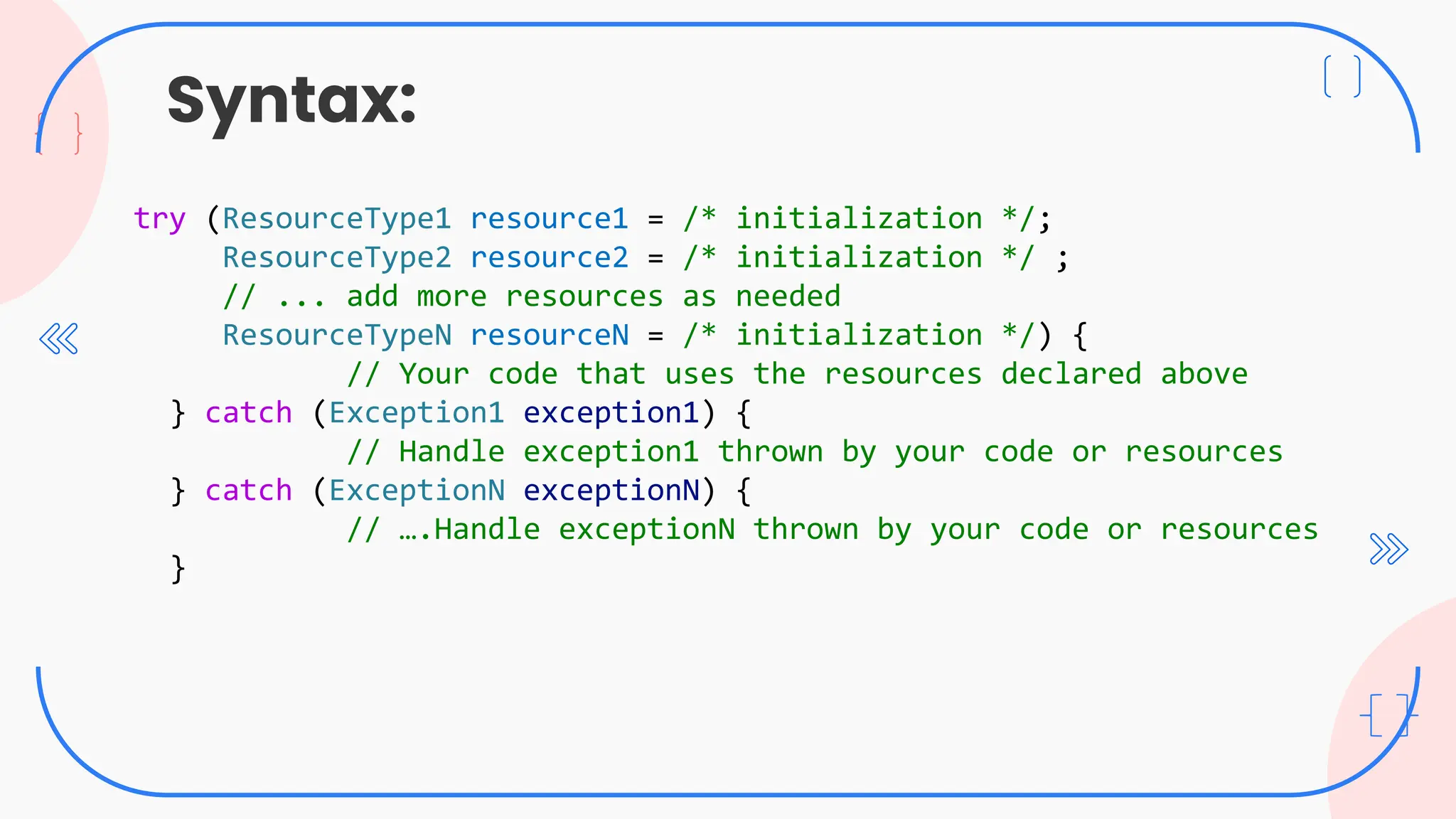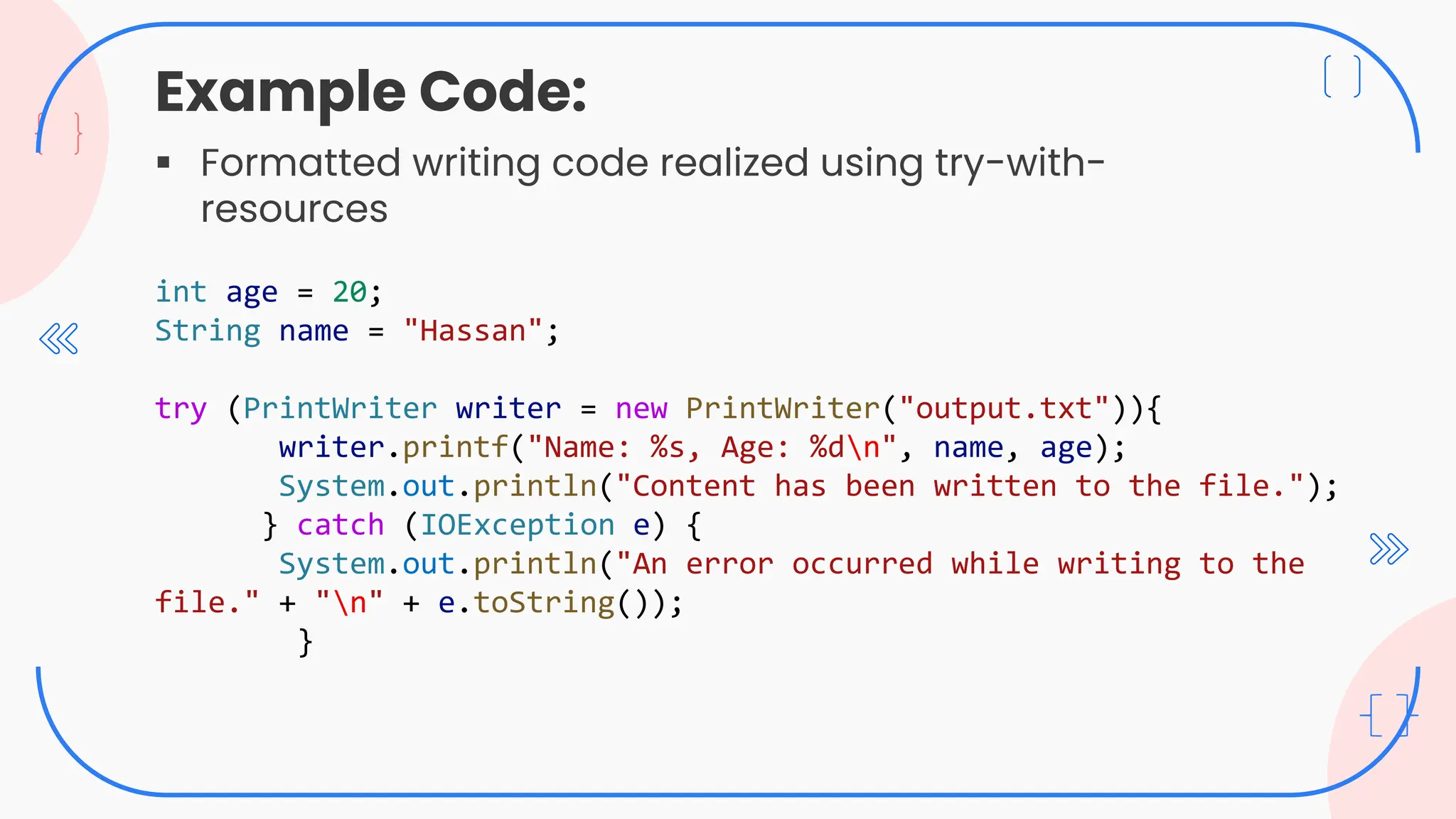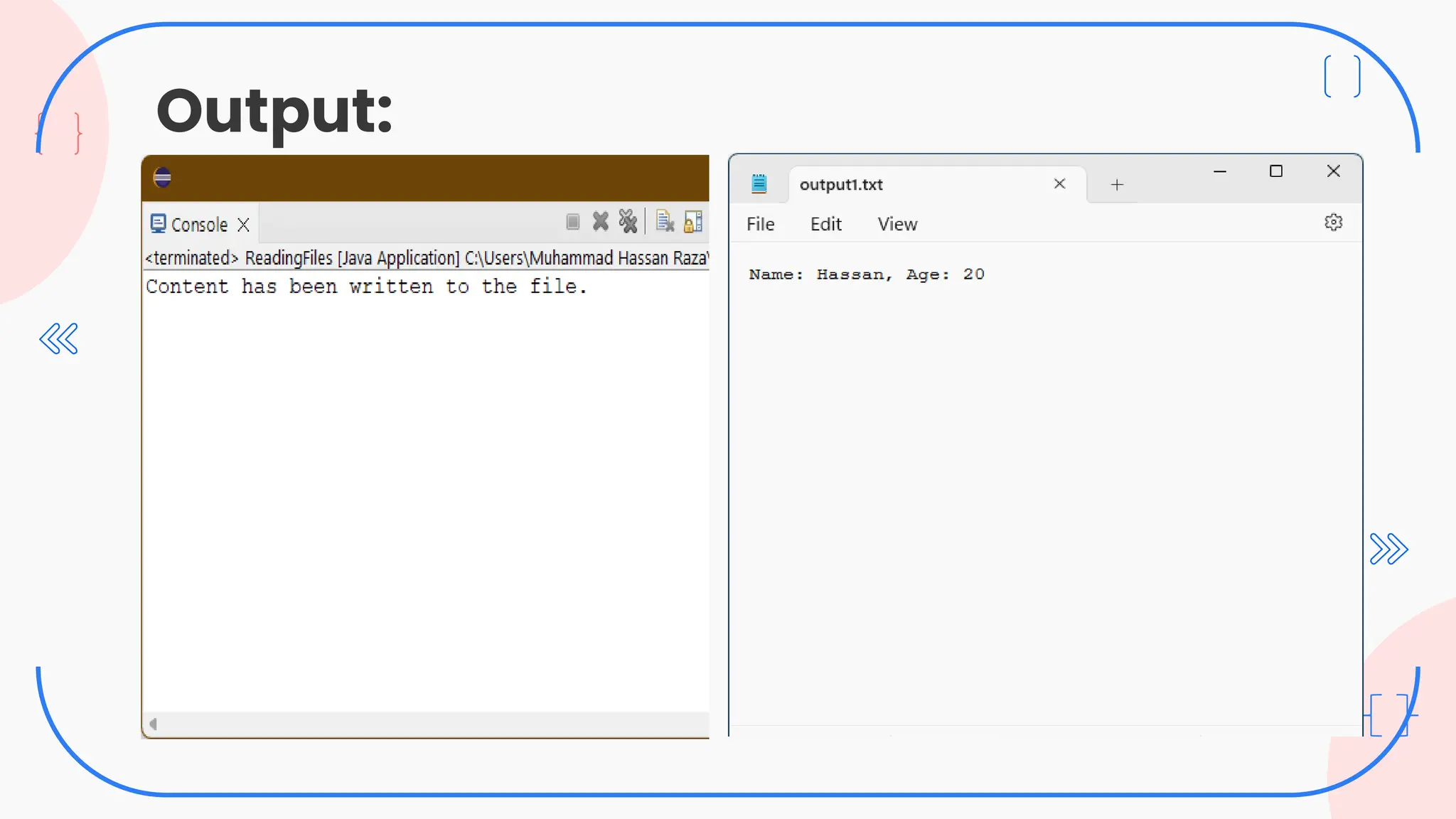The document provides an overview of file handling in Java, detailing concepts such as file types, streams, and the File class. It explains file operations including reading, writing, creating, and deleting files, while emphasizing the use of various classes for these functions like FileReader, FileWriter, and BufferedReader. Additionally, it introduces resource management practices in Java, particularly the try-with-resources statement for better resource handling.




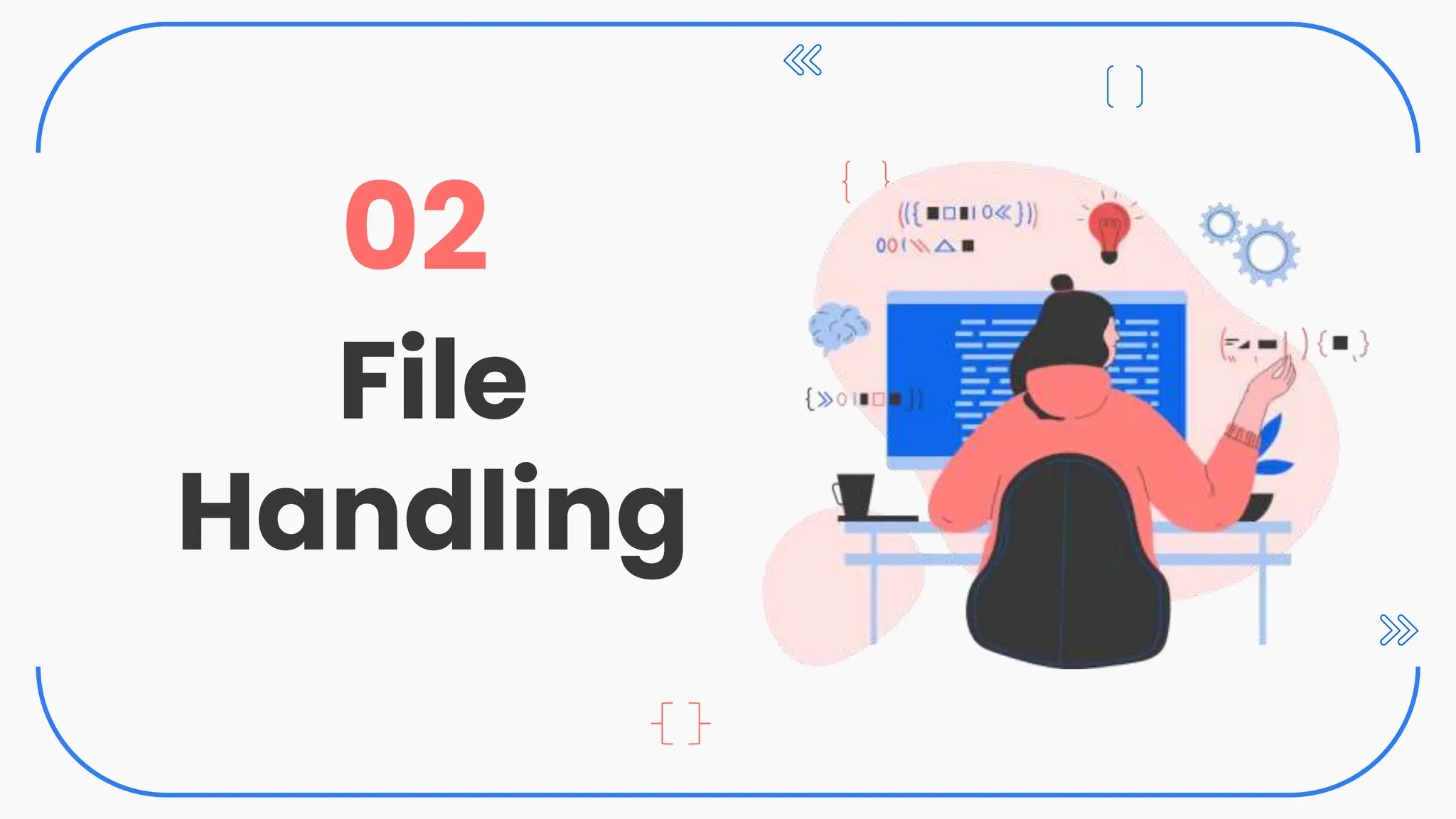
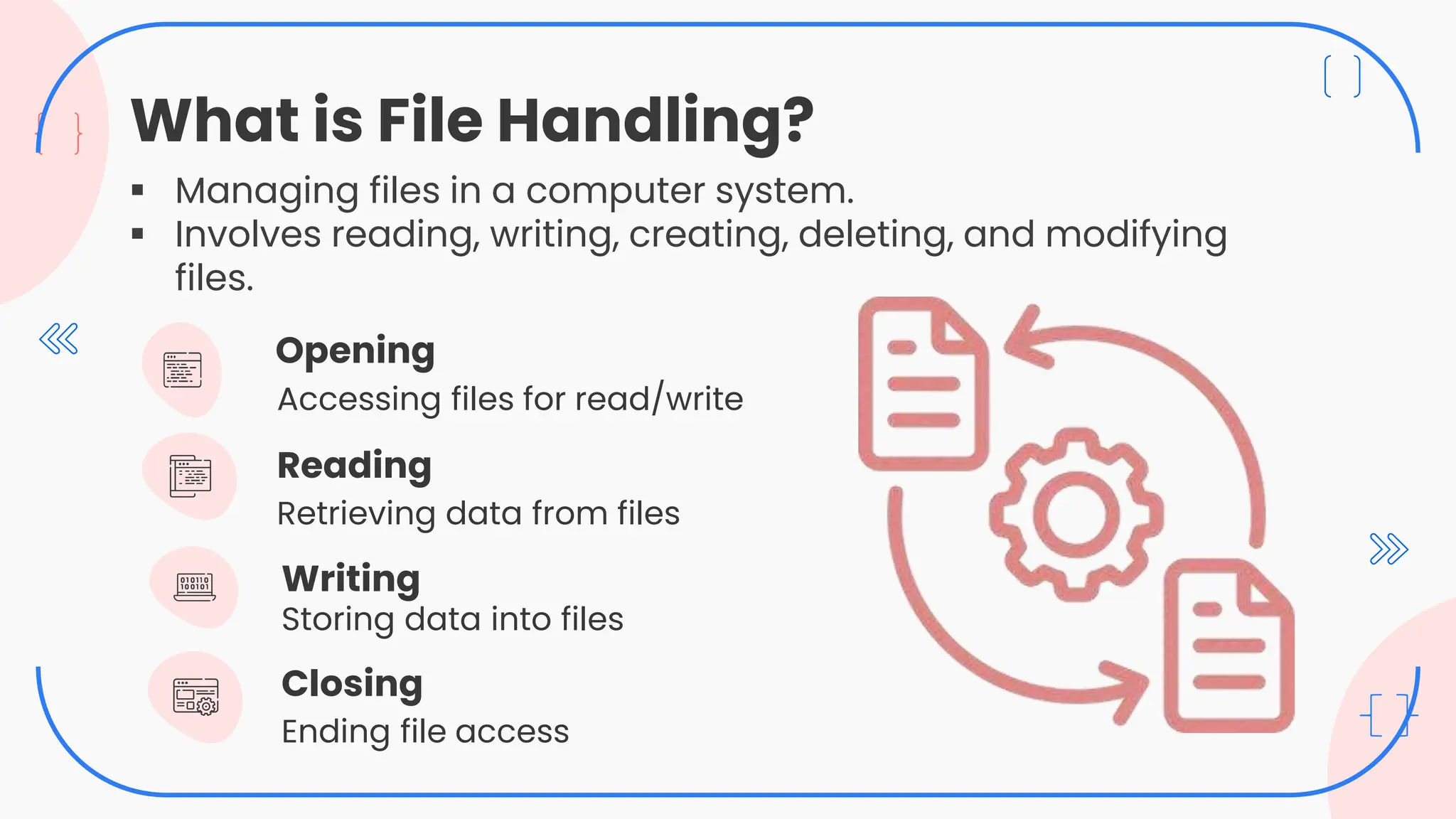
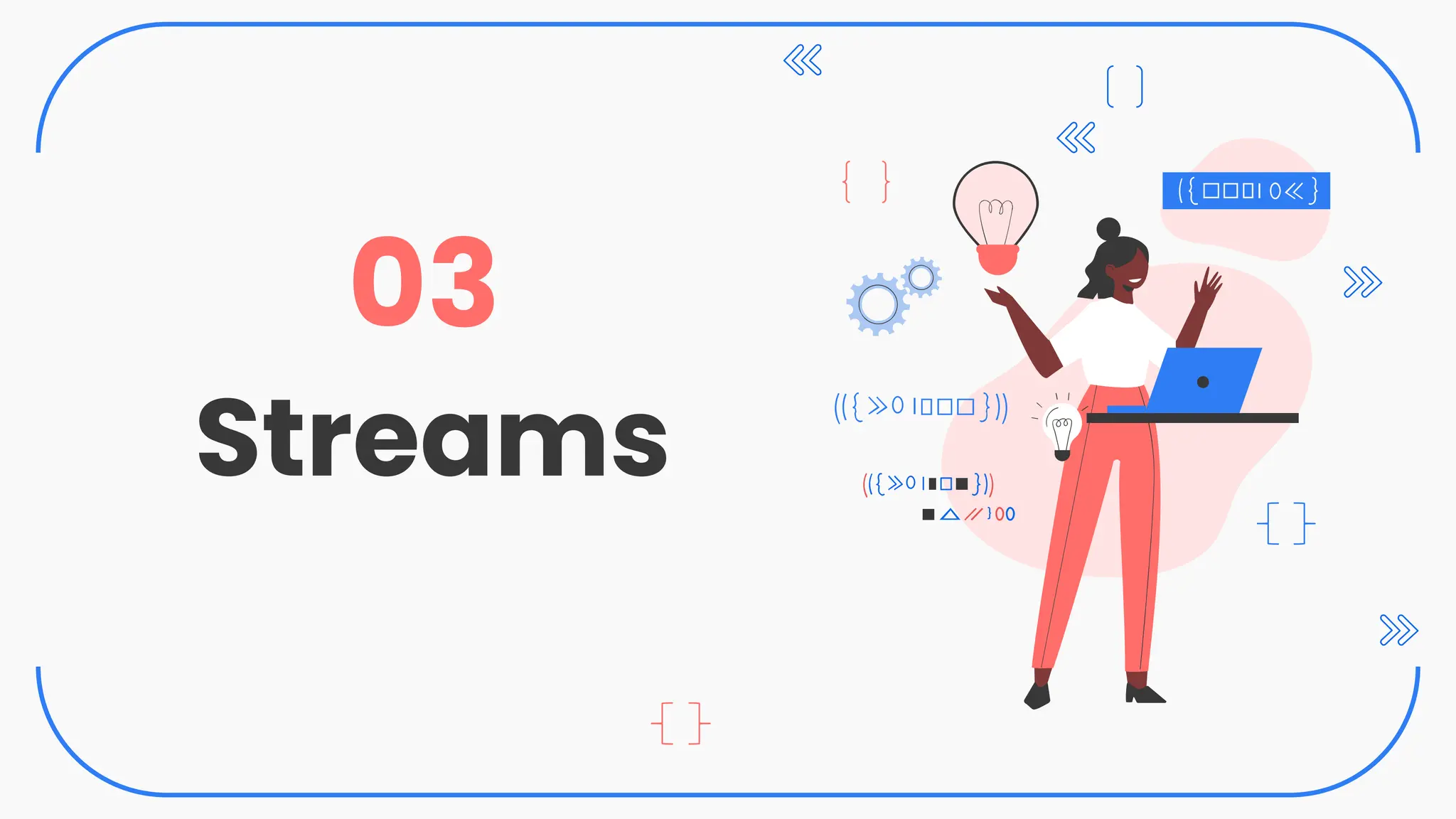
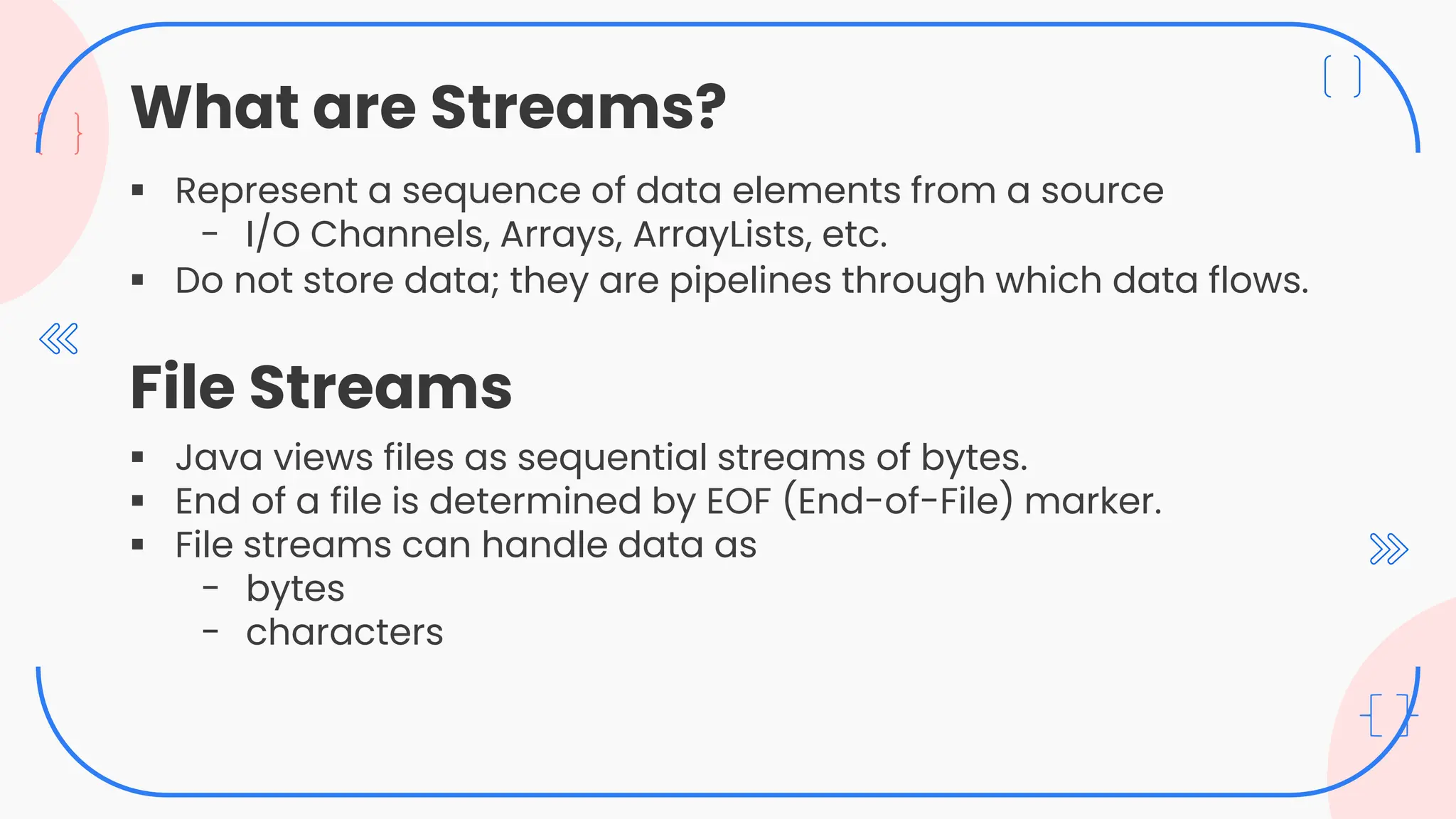
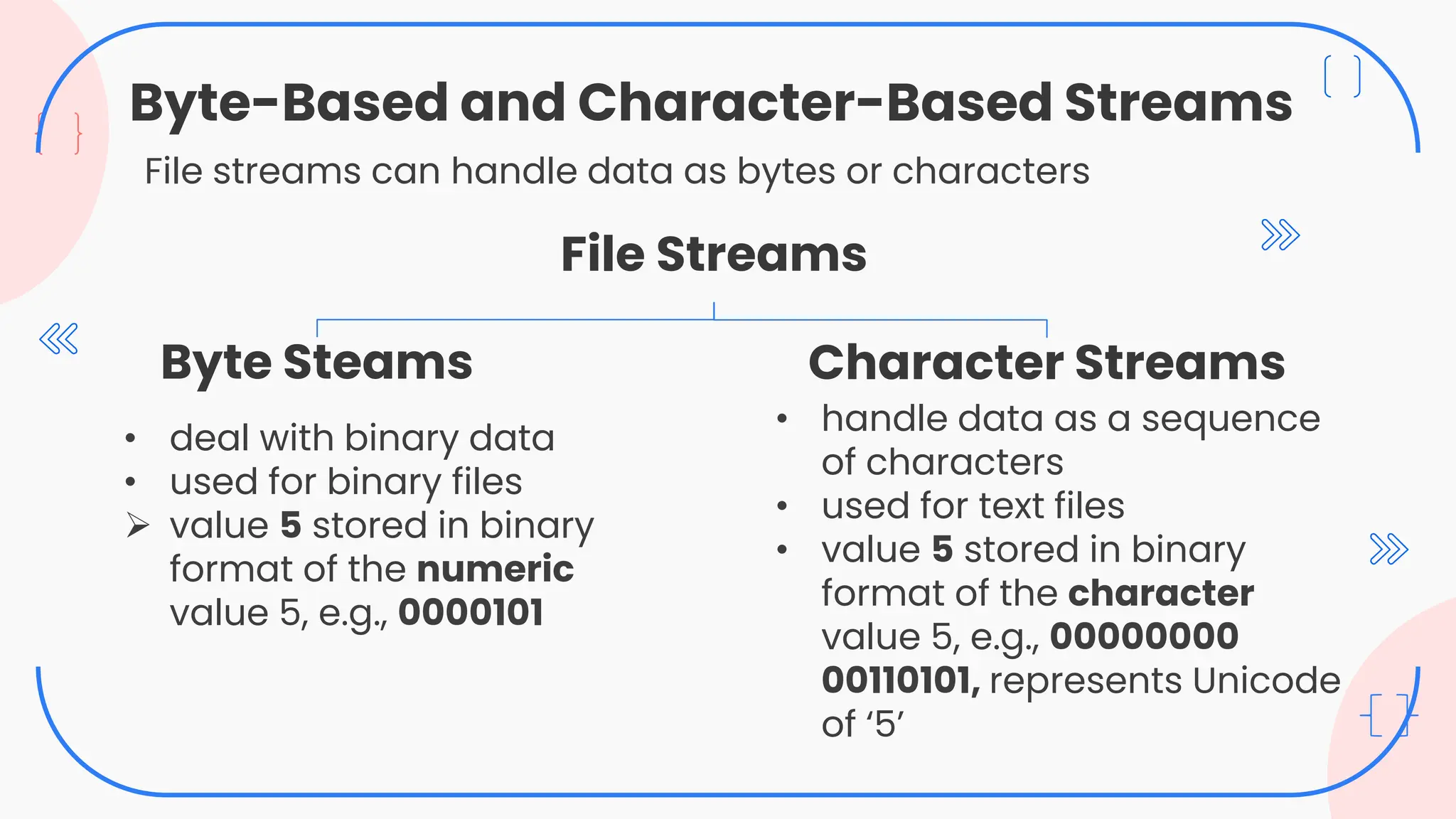
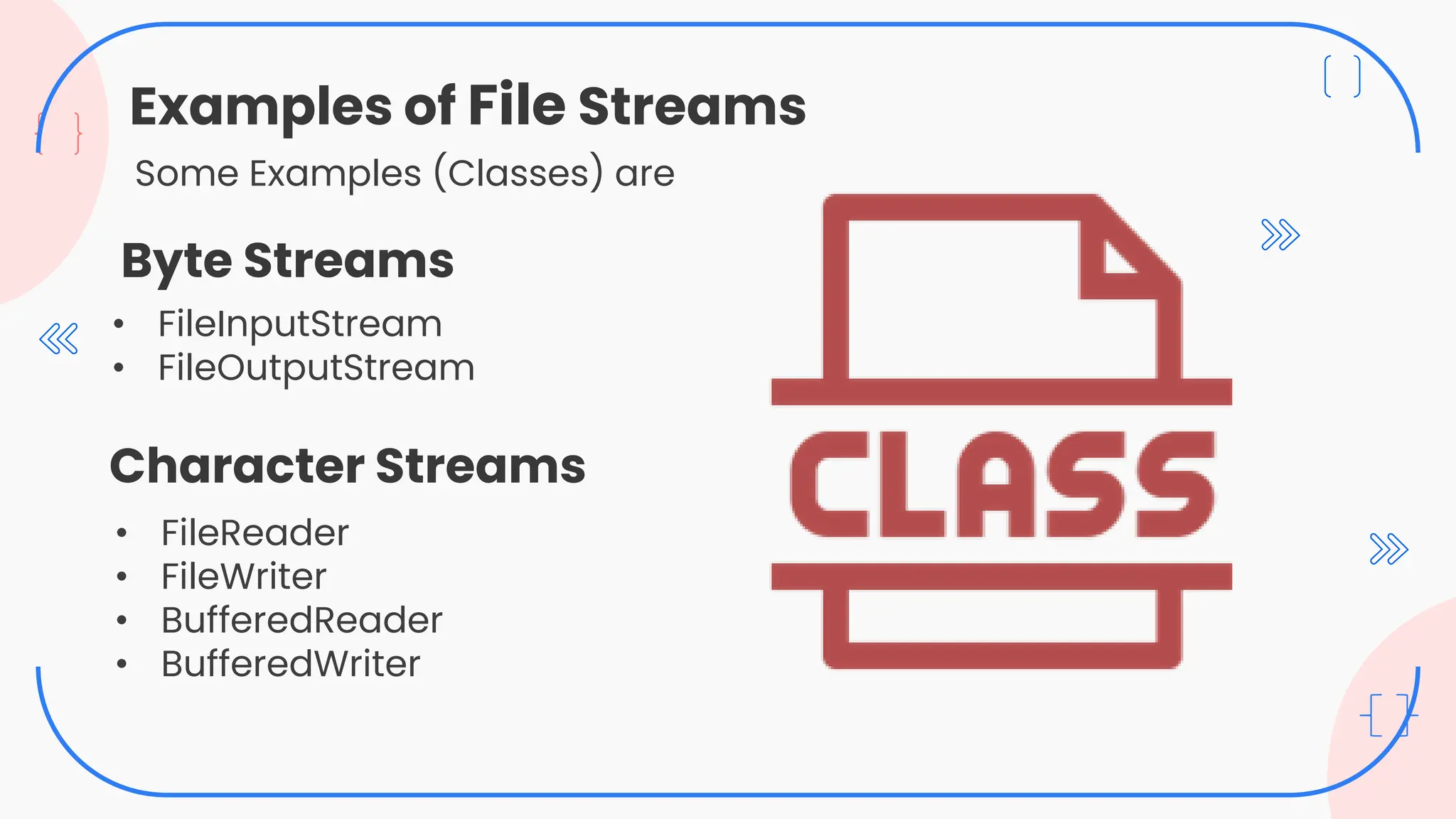

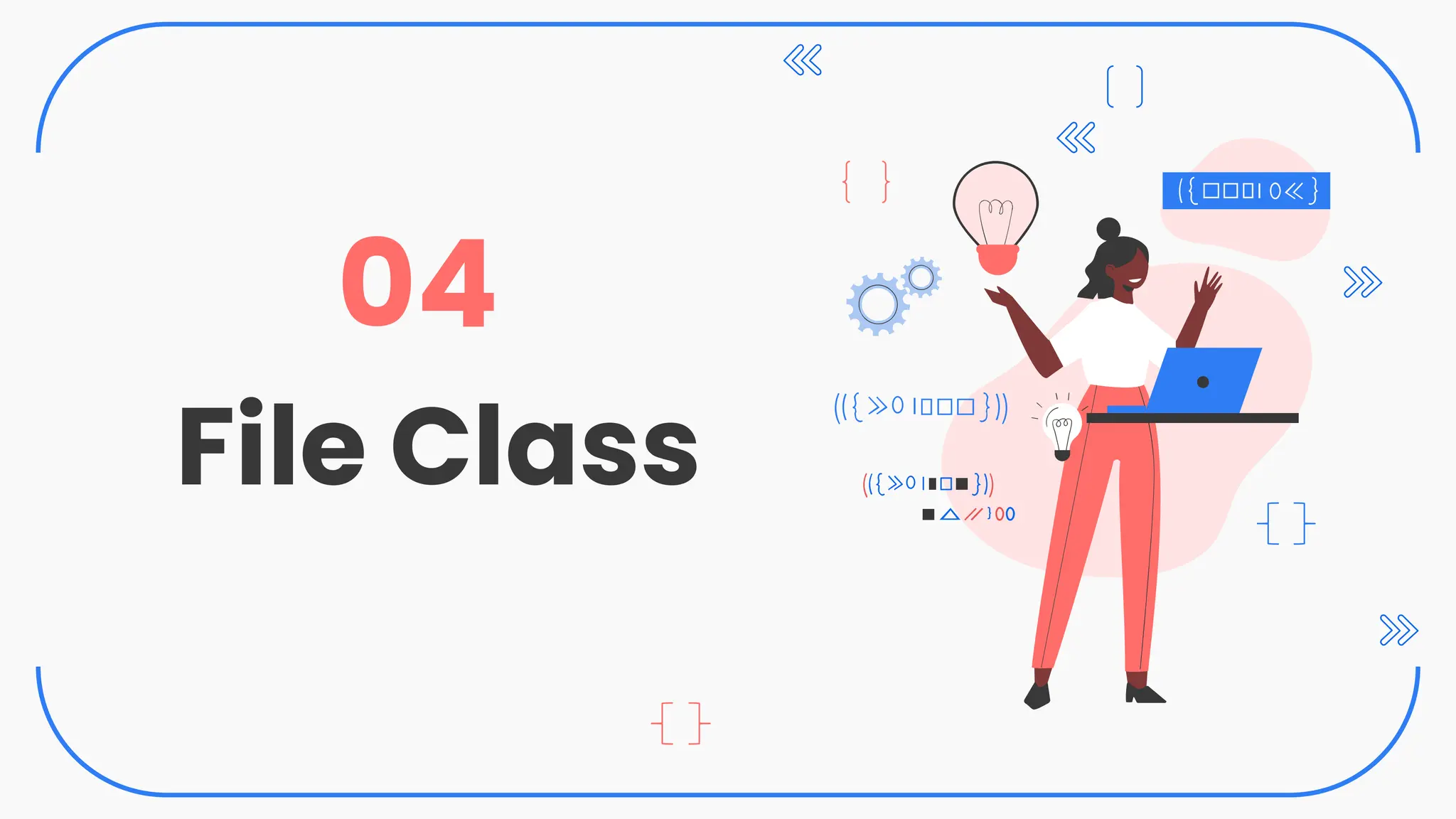
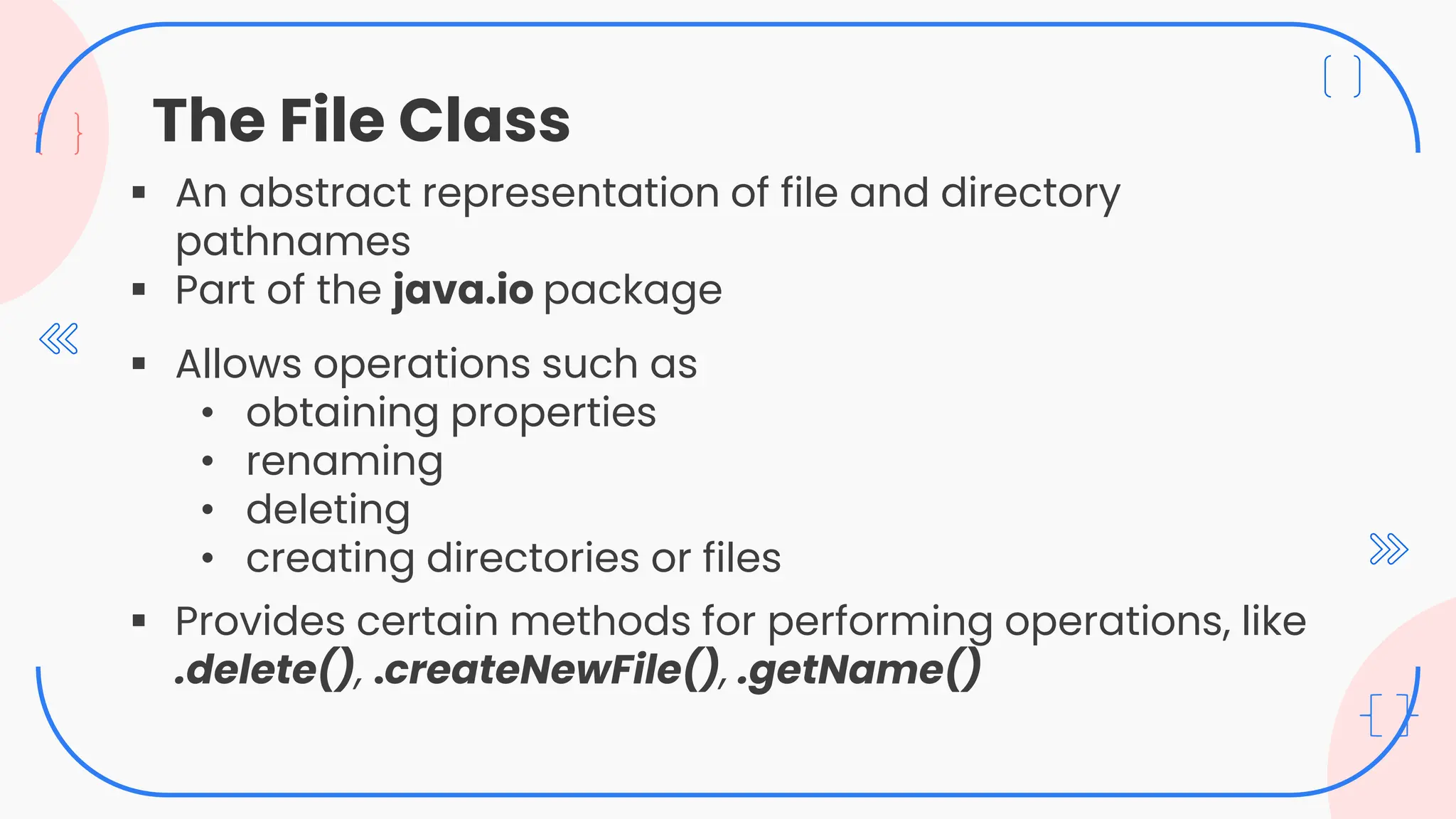
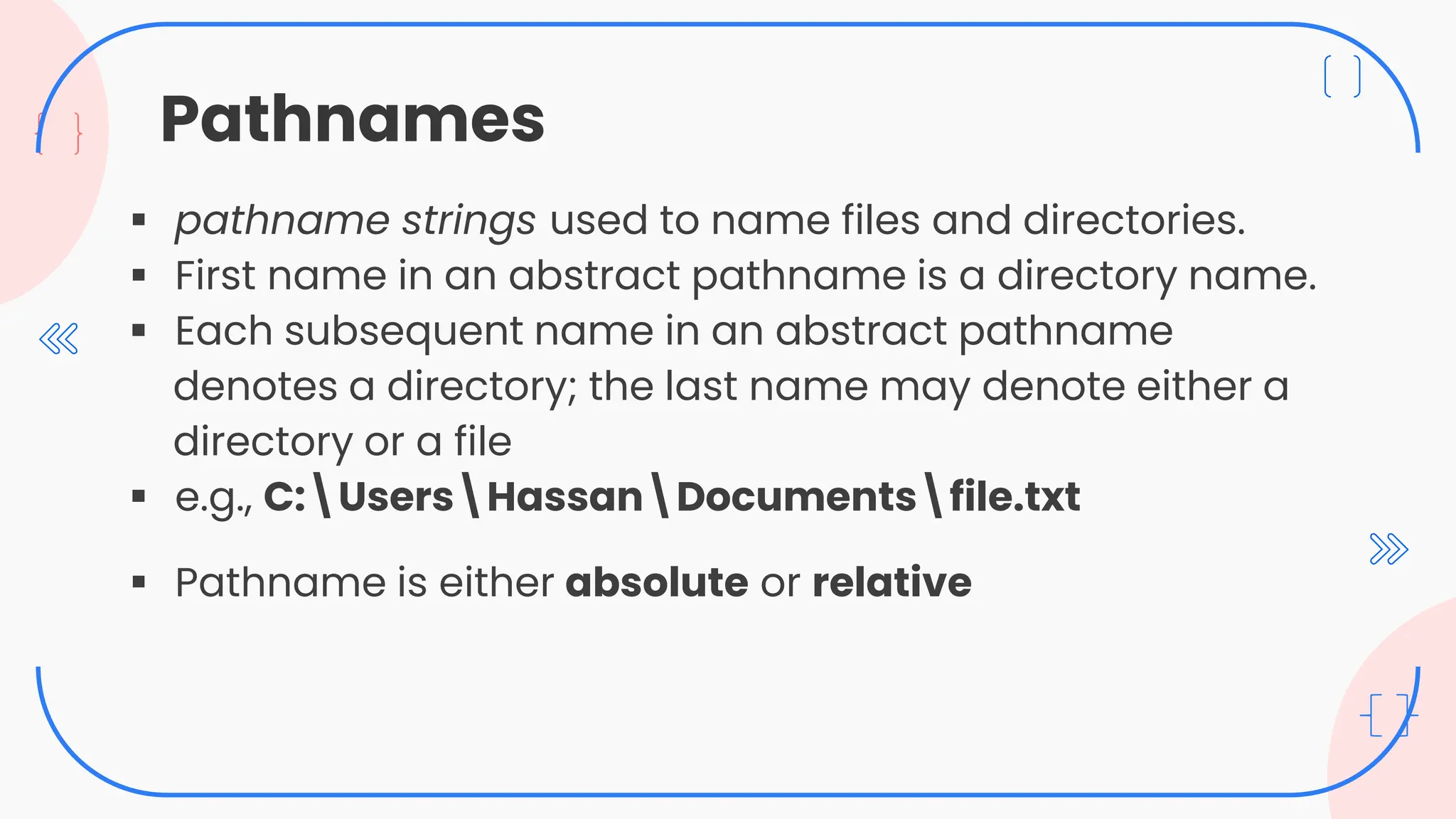
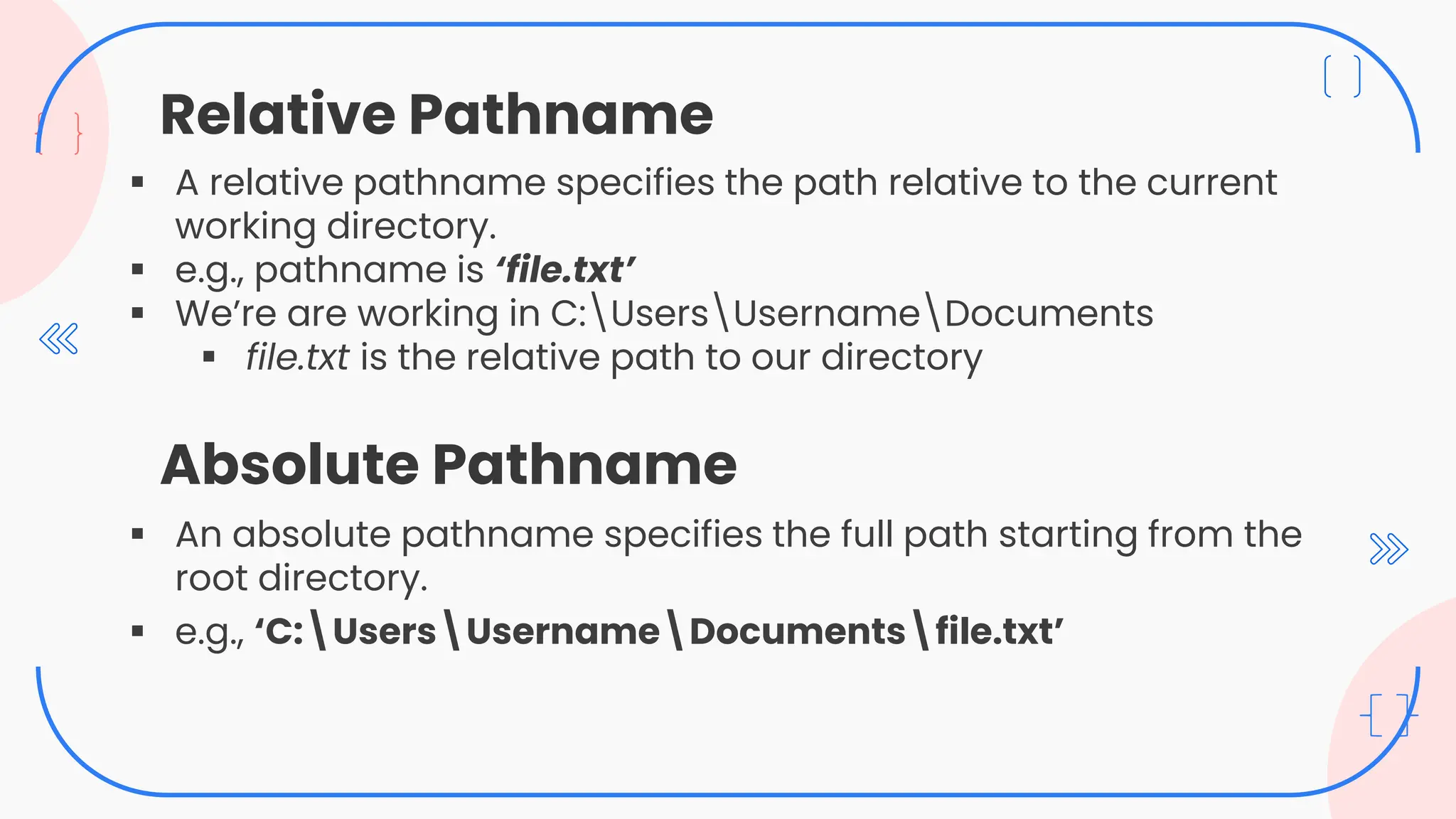
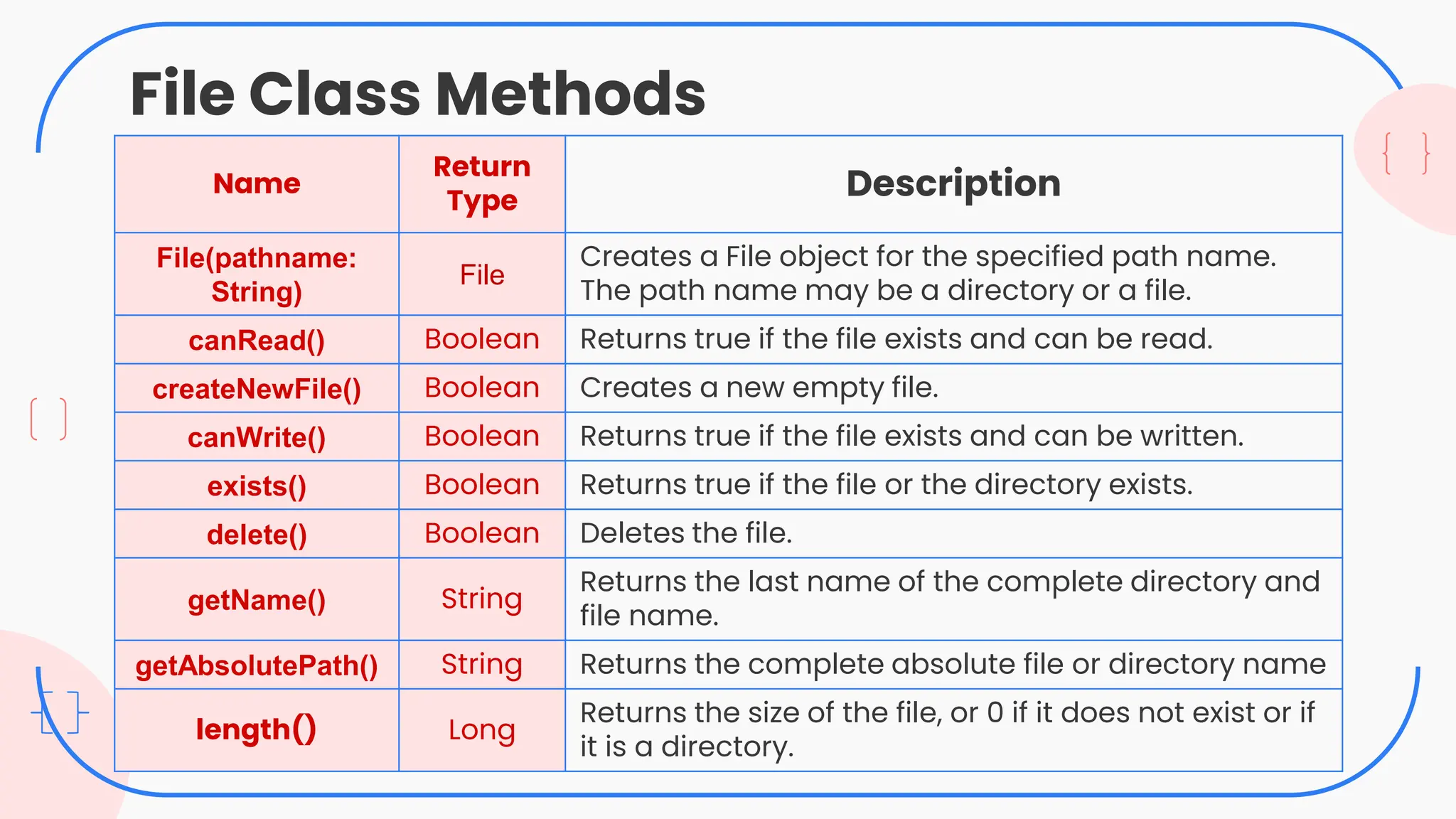
![File Class Methods
Name
Return
Type
Description
isDirectory() boolean Returns true if the File object represents a directory.
isFile() boolean Returns true if the File object represents a file.
isAbsolute() boolean
Returns true if the File object is created using an
absolute path name.
isHidden() boolean
Returns true if the file represented in the File object is
hidden.
lastModified() long Returns the time that the file was last modified.
renameTo(dest:
File)
boolean
Renames the file or directory represented by this File
object to the specified name represented in dest.
The method returns true if the operation succeeds.
list() String[] Retrieves an array of files available in the directory.
mkdir() Boolean Creates a new directory.](https://image.slidesharecdn.com/filehandling-240514034330-842c4808/75/File-Handlingb-in-java-A-brief-presentation-on-file-handling-17-2048.jpg)
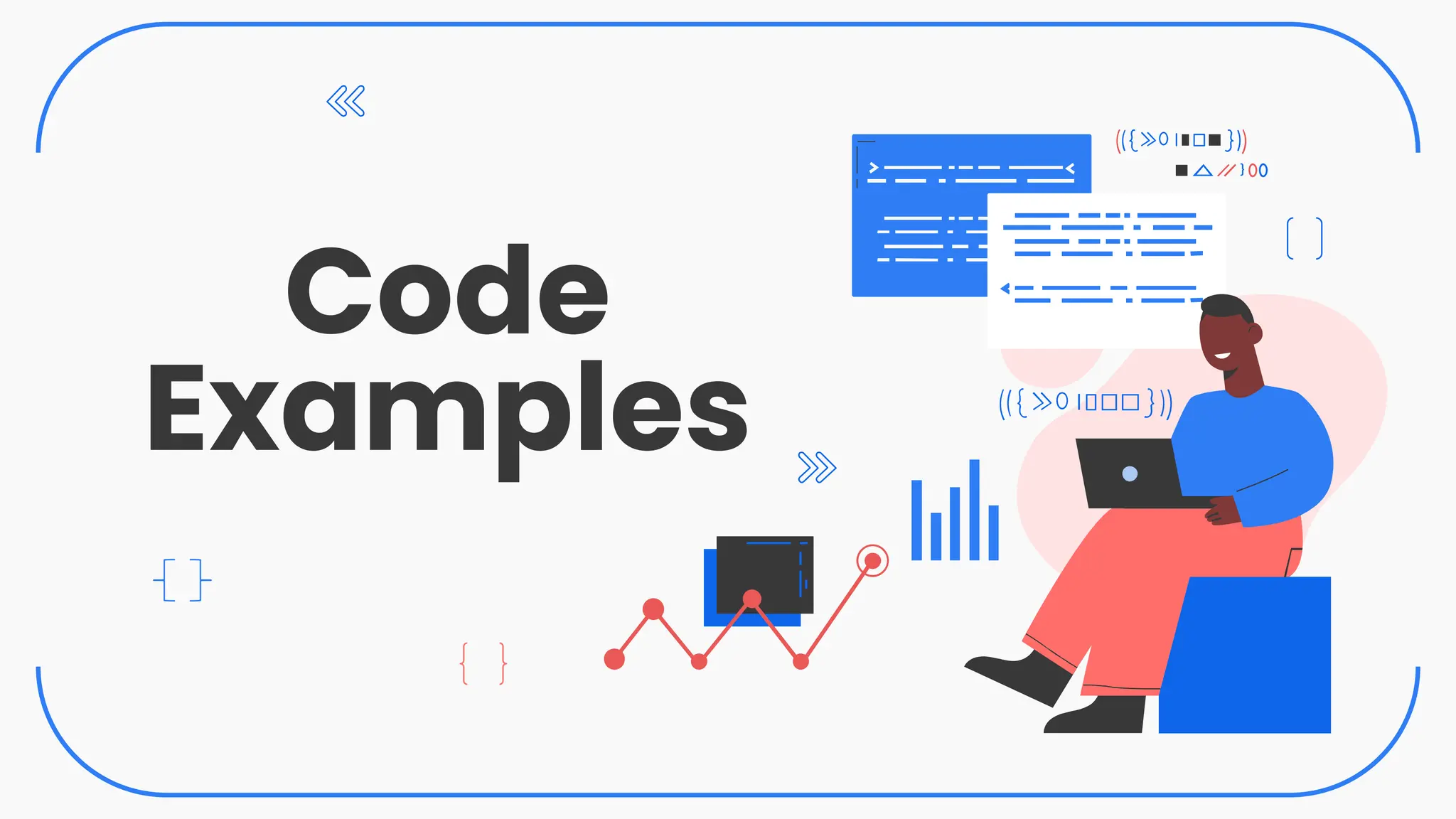
![Code:
import java.io.File;
public class FileClass {
public static void main(String[] args) {
// Create a File object
File file = new File("D:Other DataSeasons.txt");
// Check if is a file
System.out.println("Is it a file?: " + file.isFile());
// Check if file can be read and written
System.out.println("Can read file: " + file.canRead());
System.out.println("Can write to file: " + file.canWrite());
// Check if file exists
System.out.println("File exists: " + file.exists());
// Get file name and absolute path
System.out.println("File name: " + file.getName());
System.out.println("Absolute path: " + file.getAbsolutePath());
}
}](https://image.slidesharecdn.com/filehandling-240514034330-842c4808/75/File-Handlingb-in-java-A-brief-presentation-on-file-handling-19-2048.jpg)
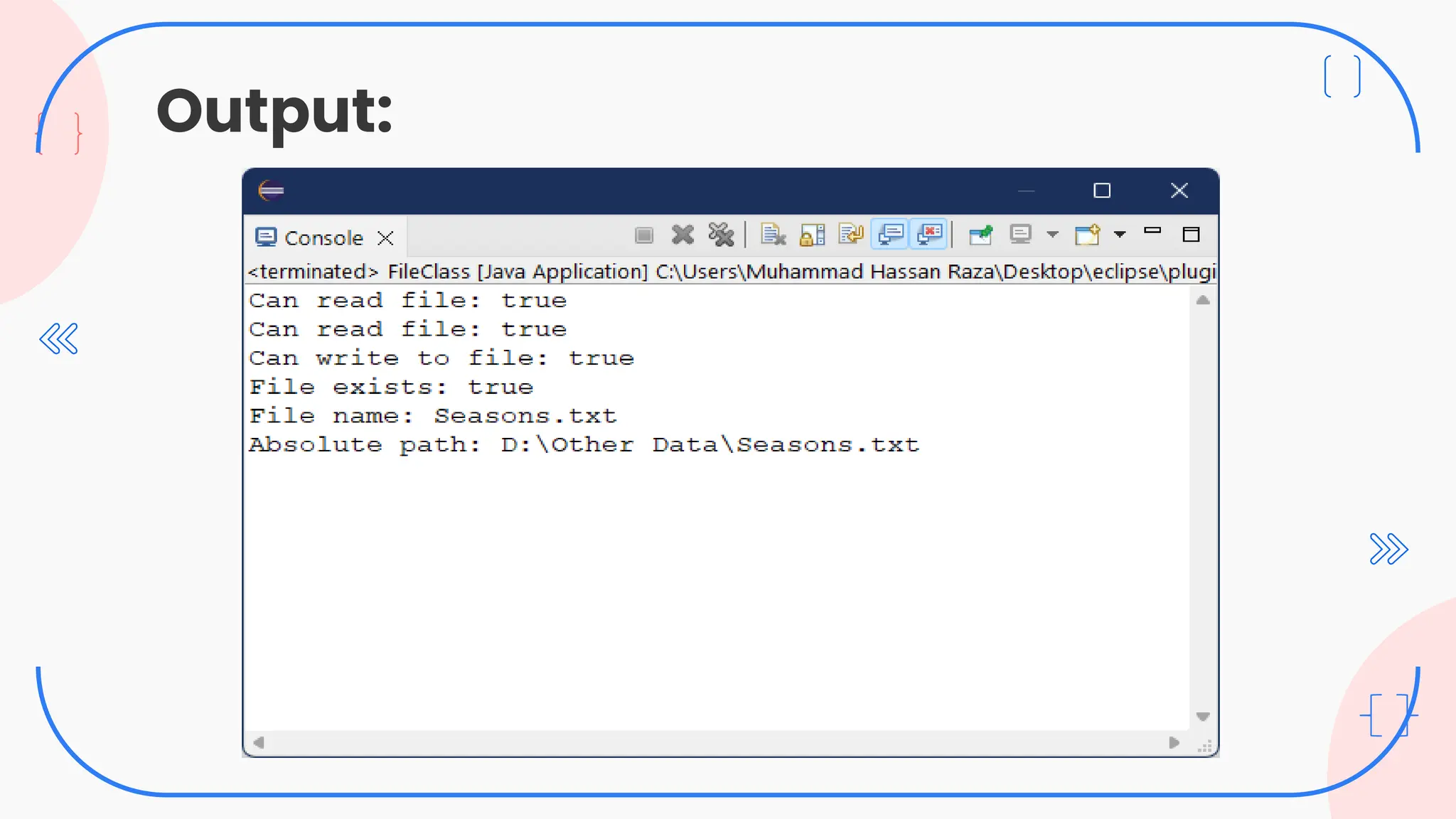
![Code:
import java.io.File;
public class FileClass {
public static void main(String[] args) {
// Create a File object
File file = new File("D:Other DataSeasons.txt");
// Get file length
System.out.println("File length (in bytes): " + file.length());
// Check if it's a directory and if it's an absolute path
System.out.println("Is directory: " + file.isDirectory());
System.out.println("Is absolute path: " + file.isAbsolute());
// Get file path, last modified time, and rename the file
System.out.println("File path: " + file.getPath());
System.out.println("Last modified: " + file.lastModified());
}
}](https://image.slidesharecdn.com/filehandling-240514034330-842c4808/75/File-Handlingb-in-java-A-brief-presentation-on-file-handling-21-2048.jpg)
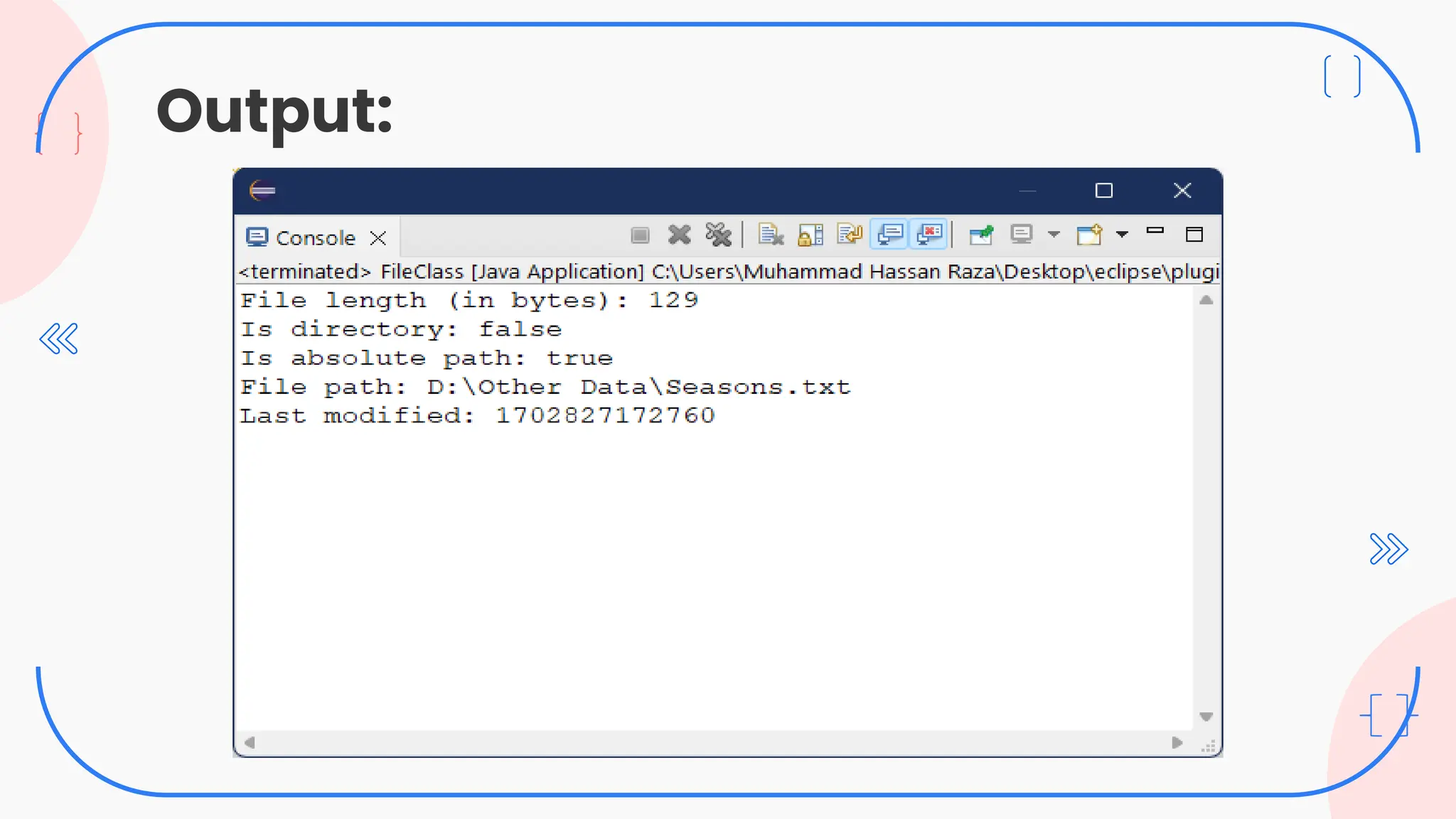
![Rename and Delete:
import java.io.File;
public class FileClass {
public static void main(String[] args) {
File file = new File("D:Other DataSeasons.txt");
// rename the file
String newName = "Unwatched Seasons.txt";
File newFile = new File(file.getParent(), newName);
if (file.renameTo(newFile)) {
System.out.println("File renamed successfully.");
} else {
System.out.println("Failed to rename the file.");
} // Deleting the file
if (file.delete()) {
System.out.println("File deleted successfully.");
} else {
System.out.println("Failed to delete the file.");
}
}
}](https://image.slidesharecdn.com/filehandling-240514034330-842c4808/75/File-Handlingb-in-java-A-brief-presentation-on-file-handling-23-2048.jpg)
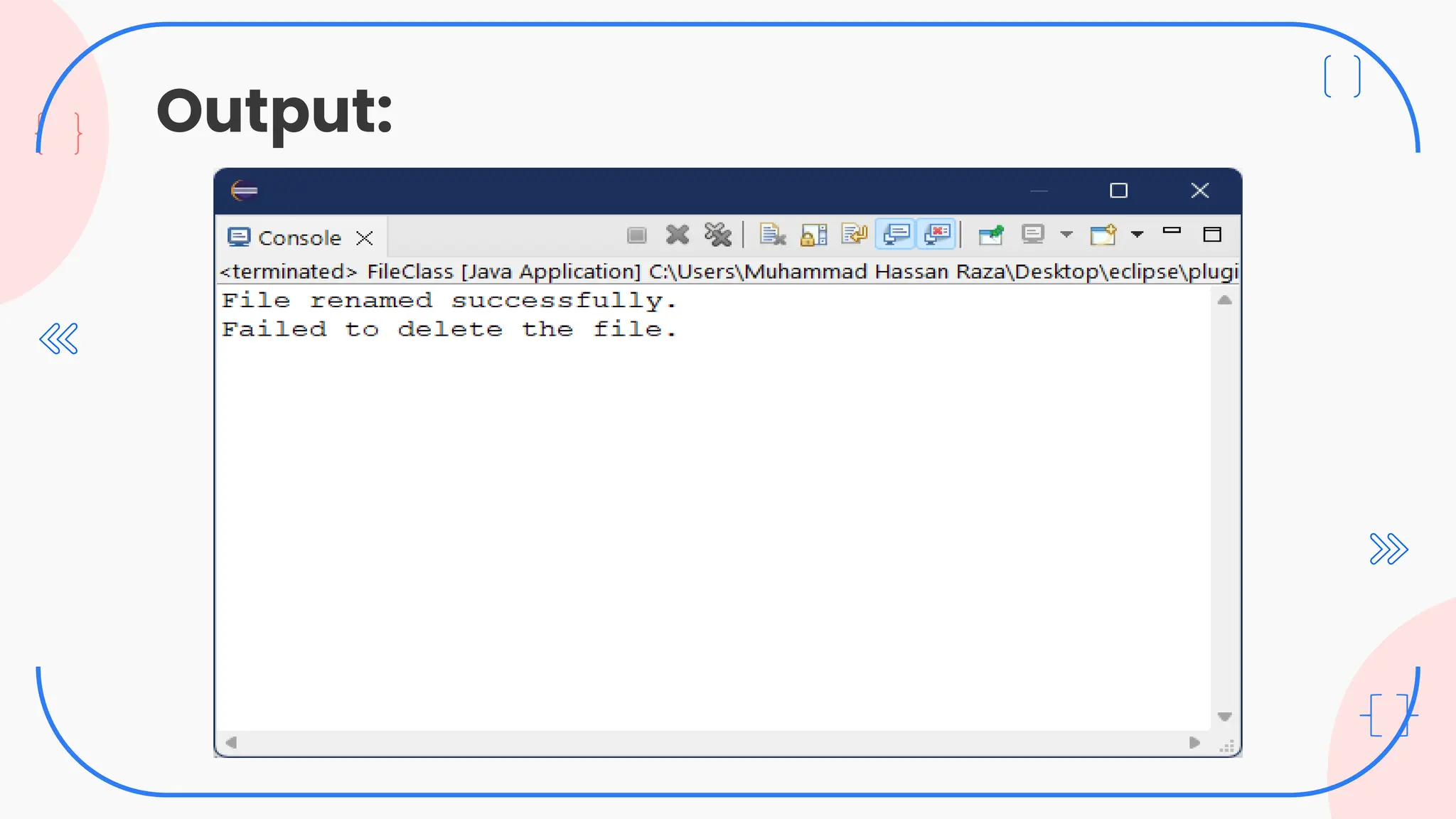
![Create a File:
import java.io.File;
import java.io.IOException;
public class FileClass {
public static void main(String[] args) {
File file = new File("D:Other DataSeasons.txt");
try {
// Creating a new file
if (file.createNewFile()) {
System.out.println("File created successfully at: " +
file.getAbsolutePath());
} else {
System.out.println("File already exists.");
}
} catch (IOException e) {
System.out.println("An error occurred while creating the file.");
e.printStackTrace();
}
}
}](https://image.slidesharecdn.com/filehandling-240514034330-842c4808/75/File-Handlingb-in-java-A-brief-presentation-on-file-handling-25-2048.jpg)
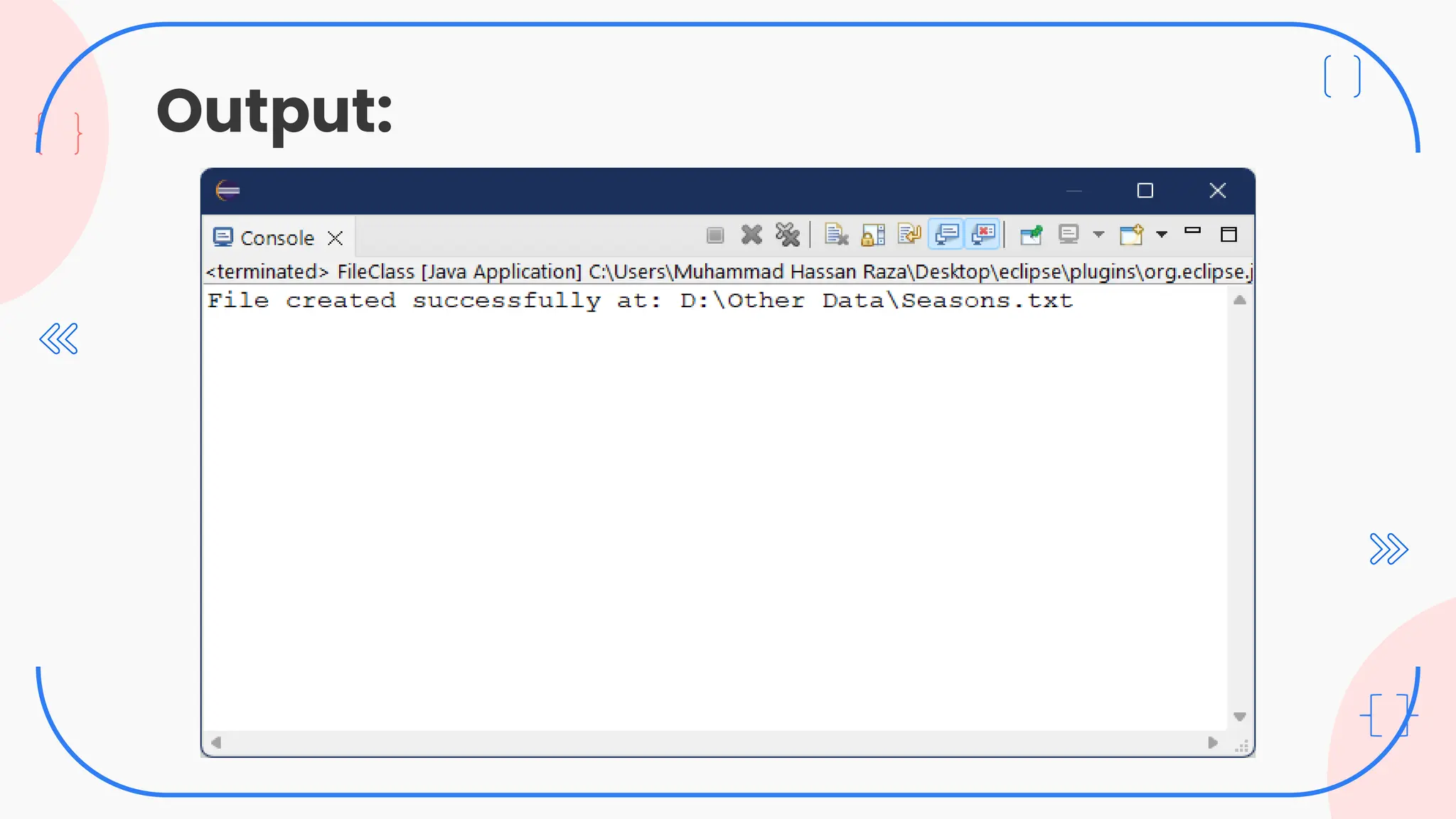
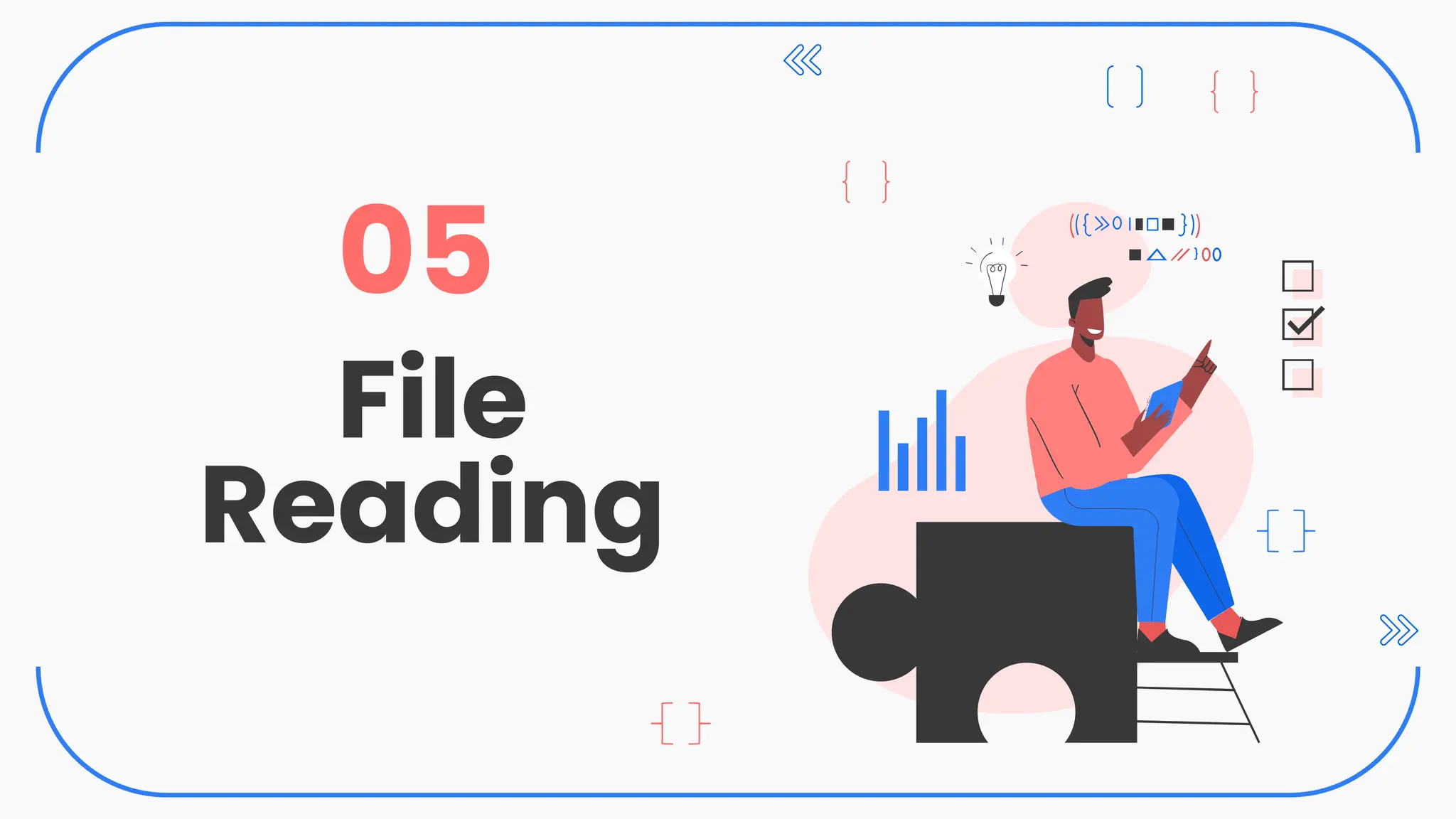
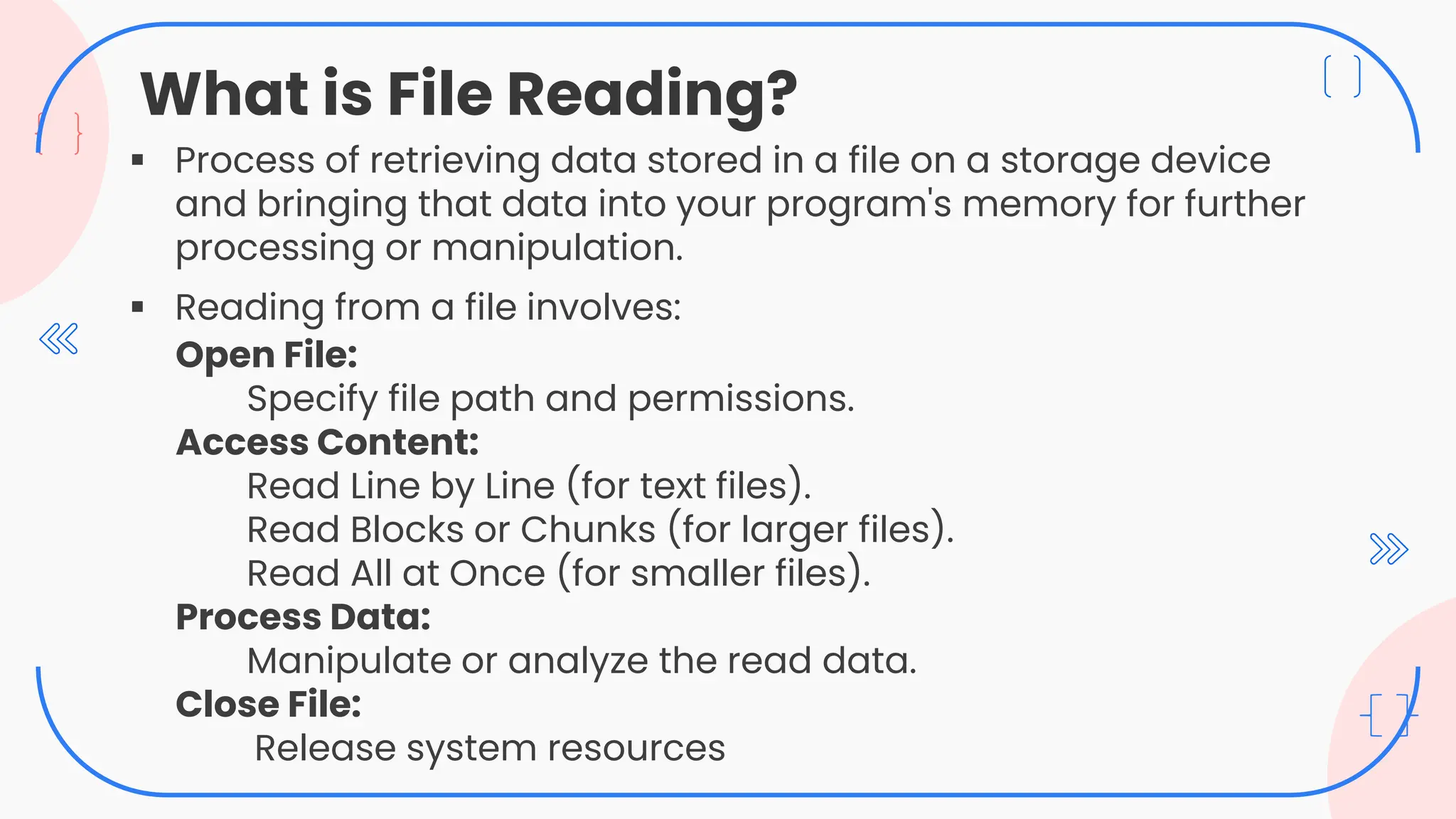
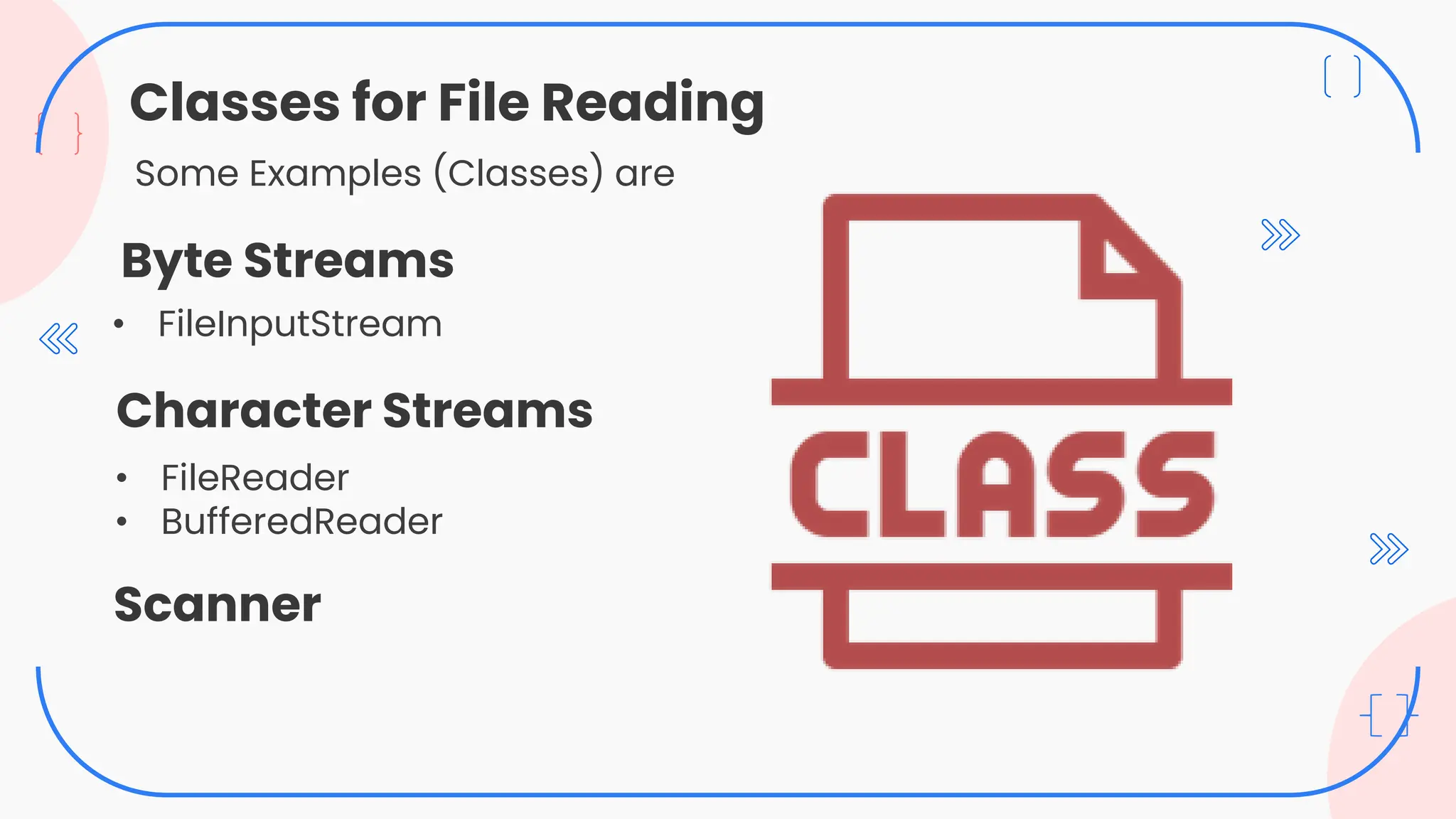

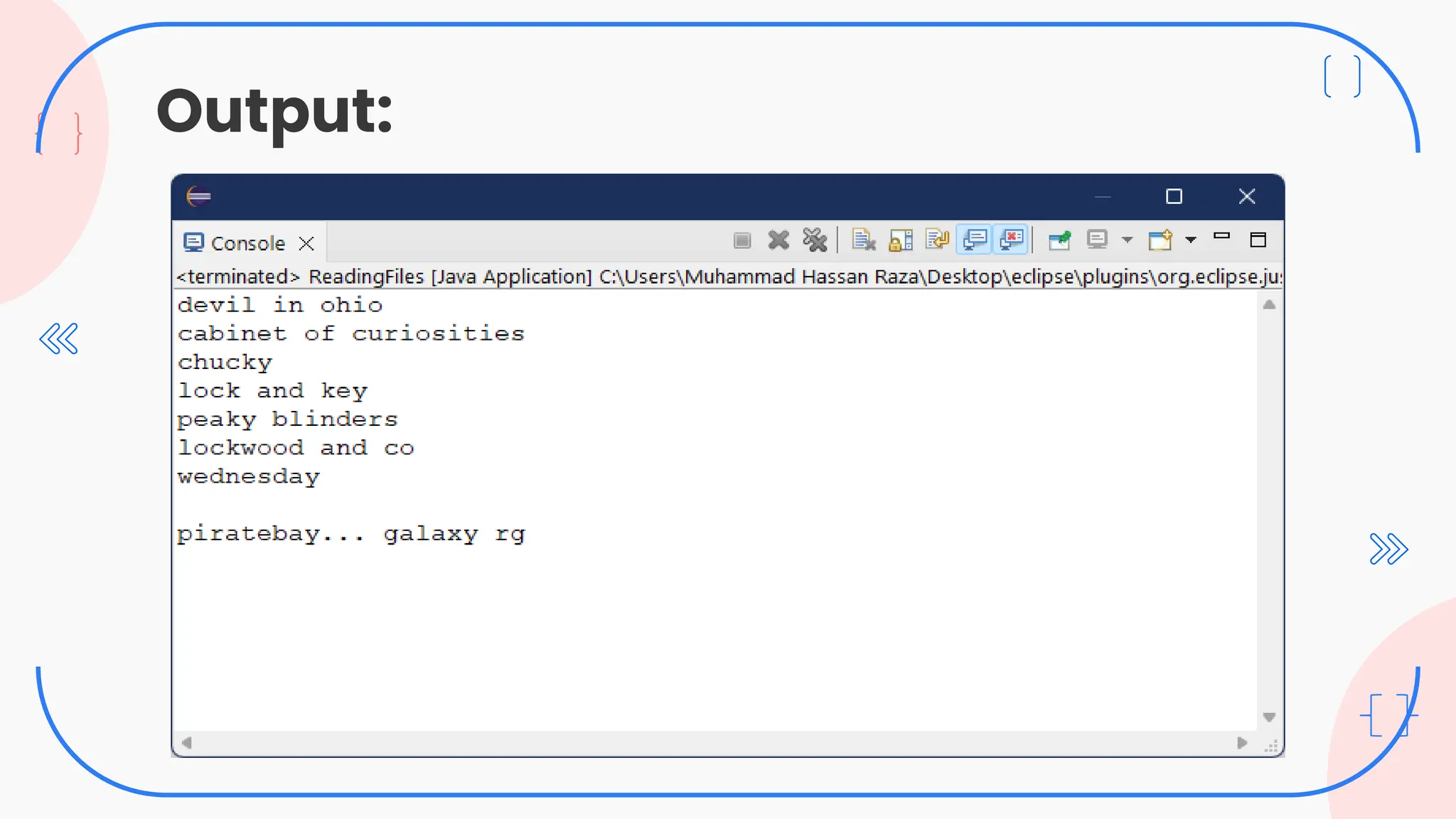

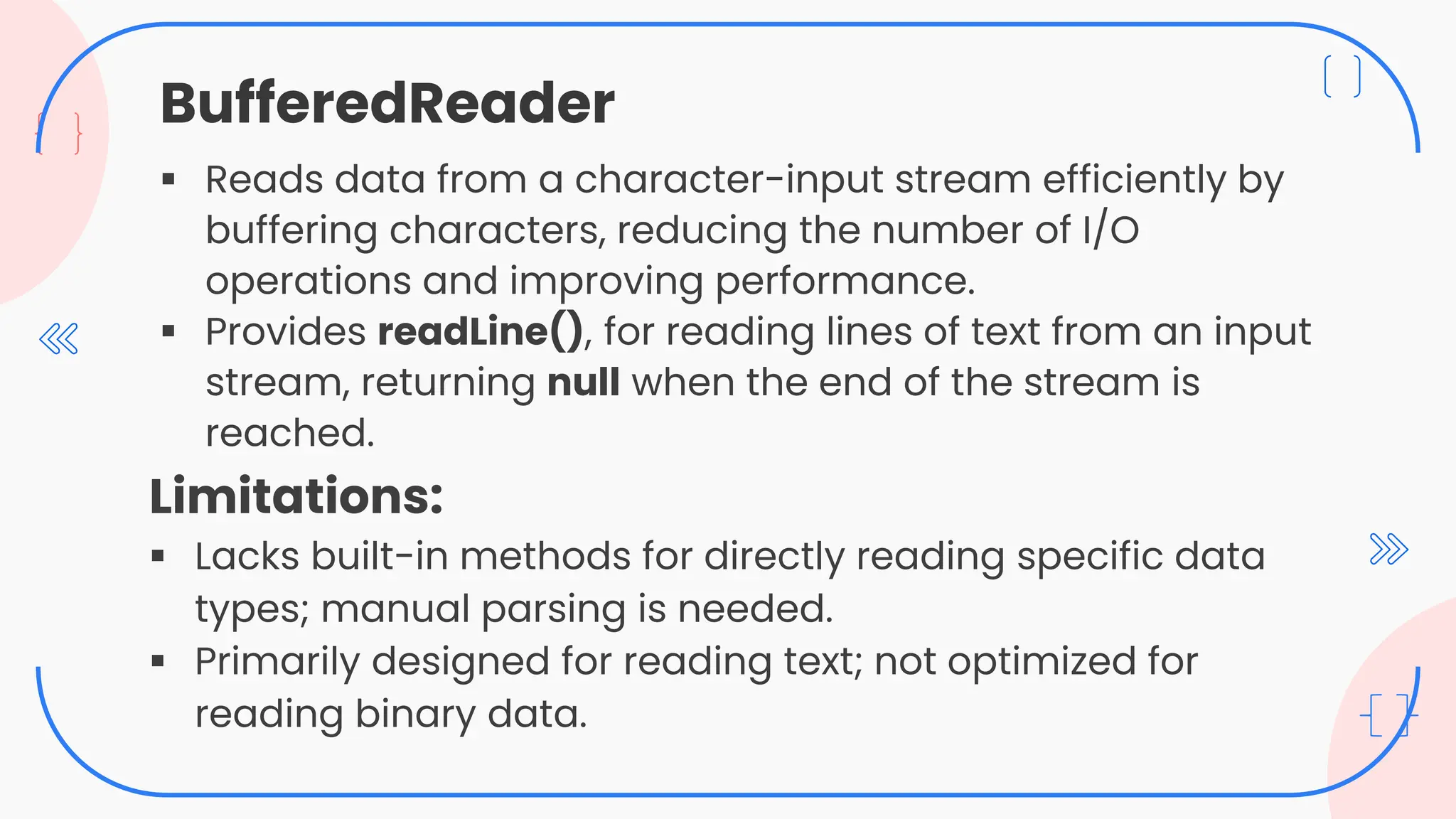
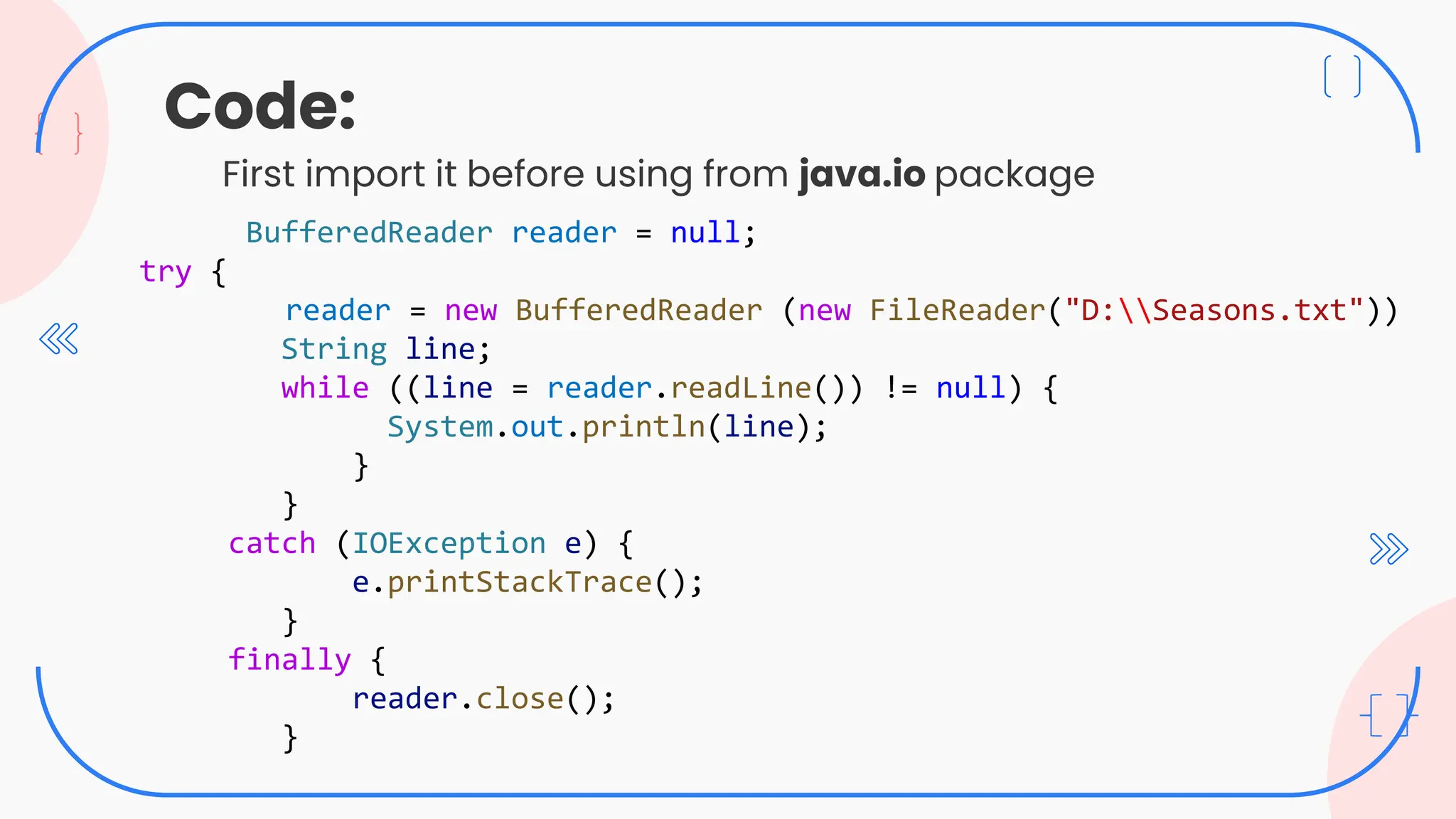
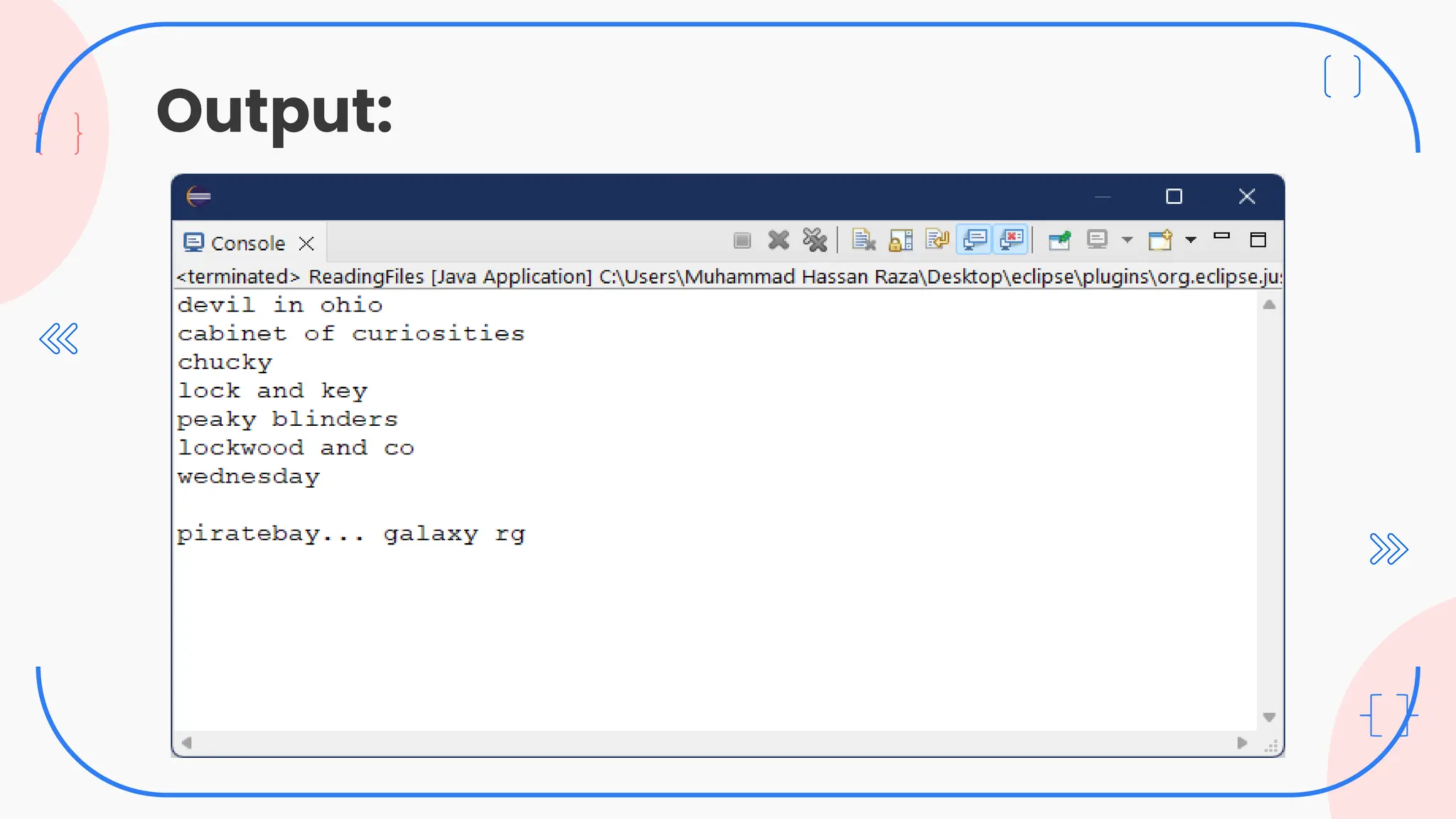

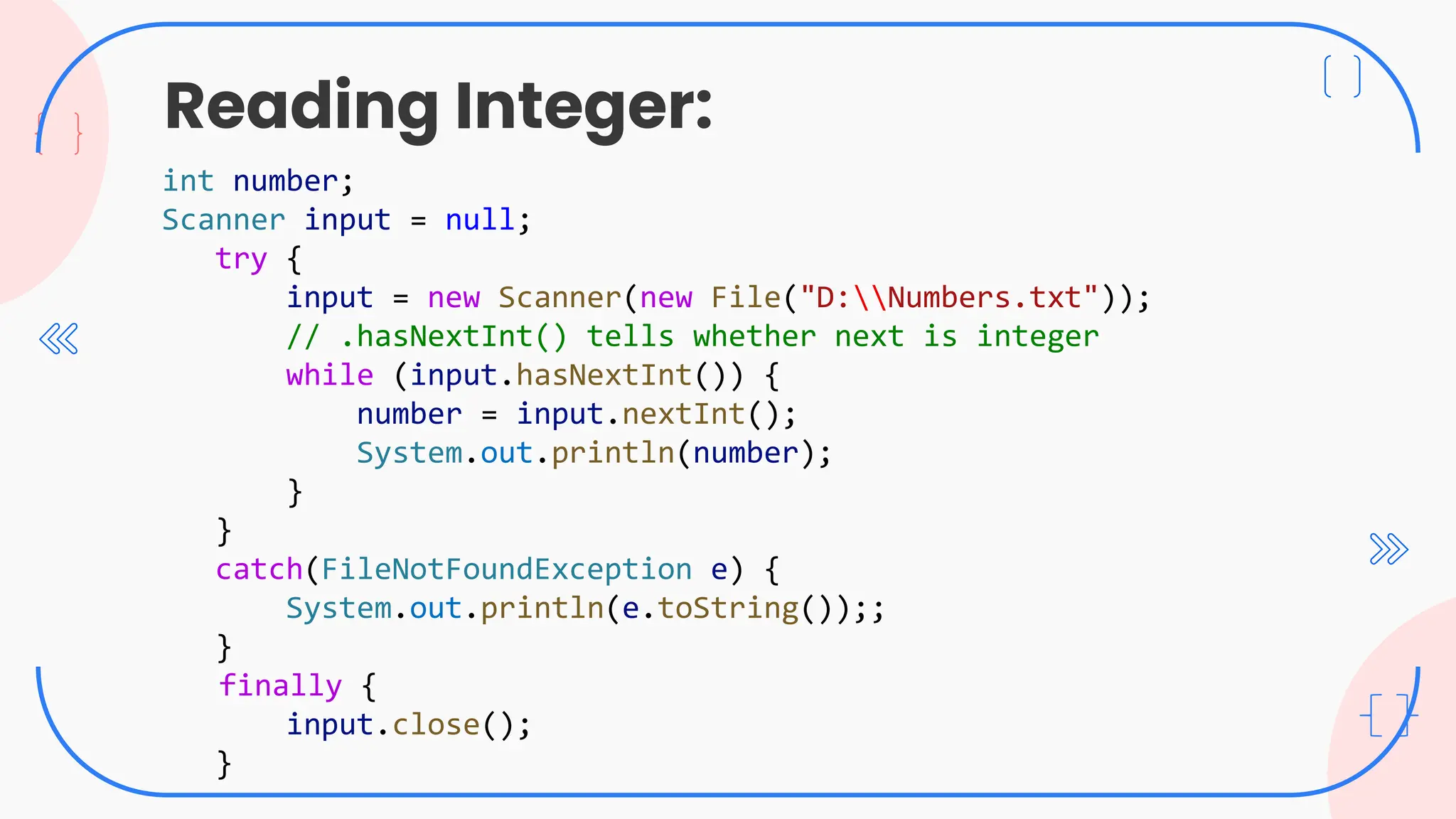
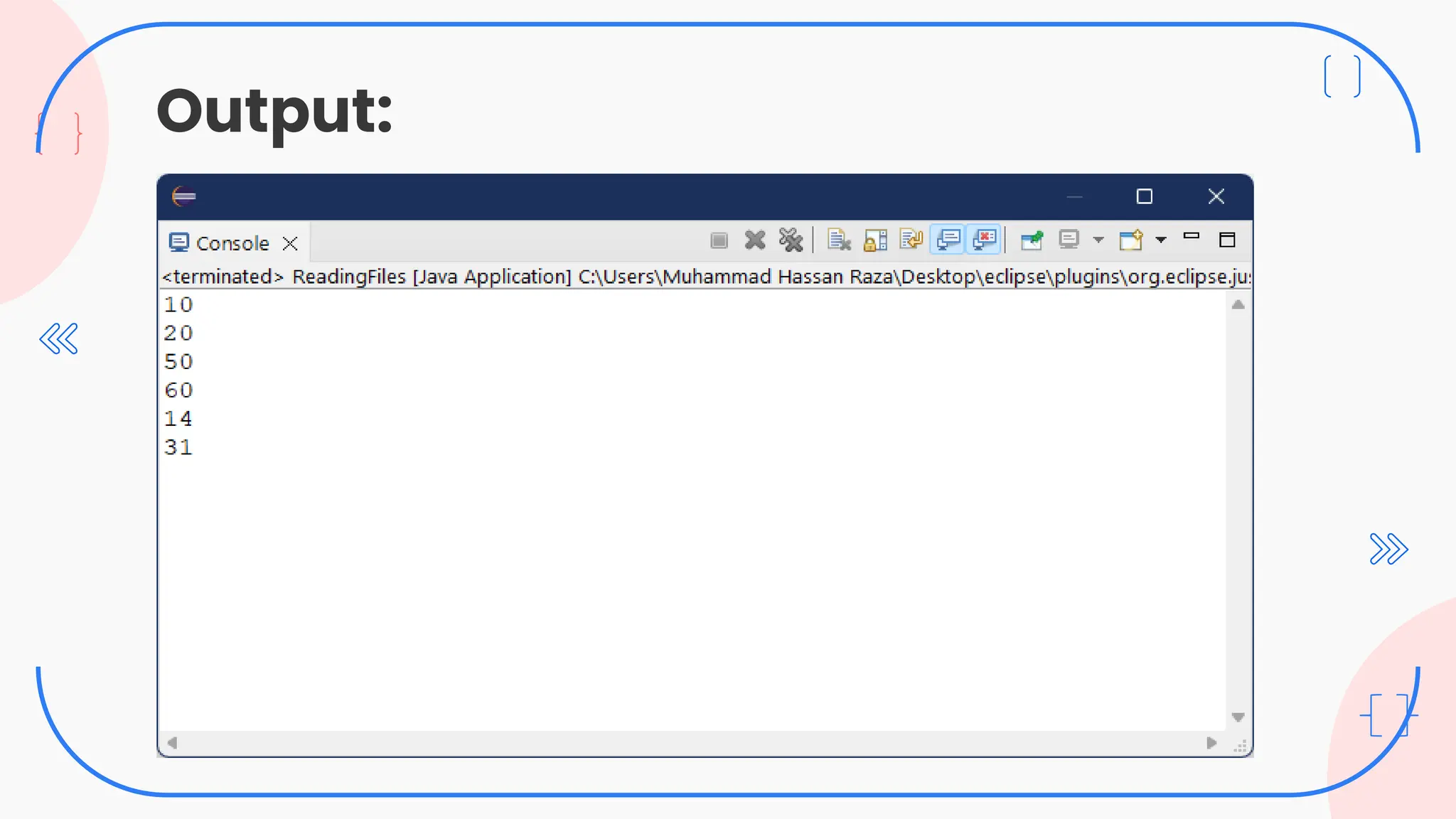
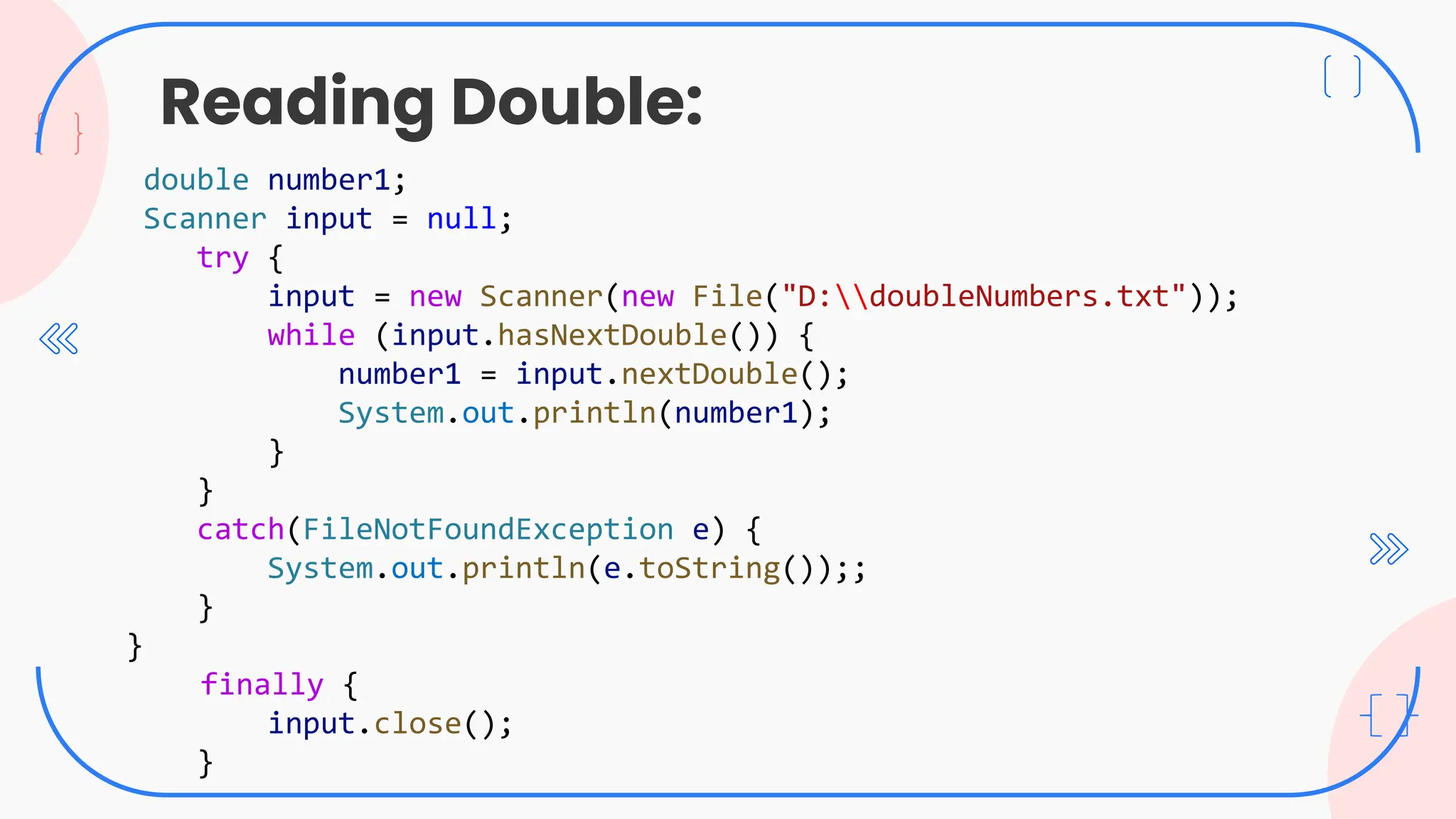
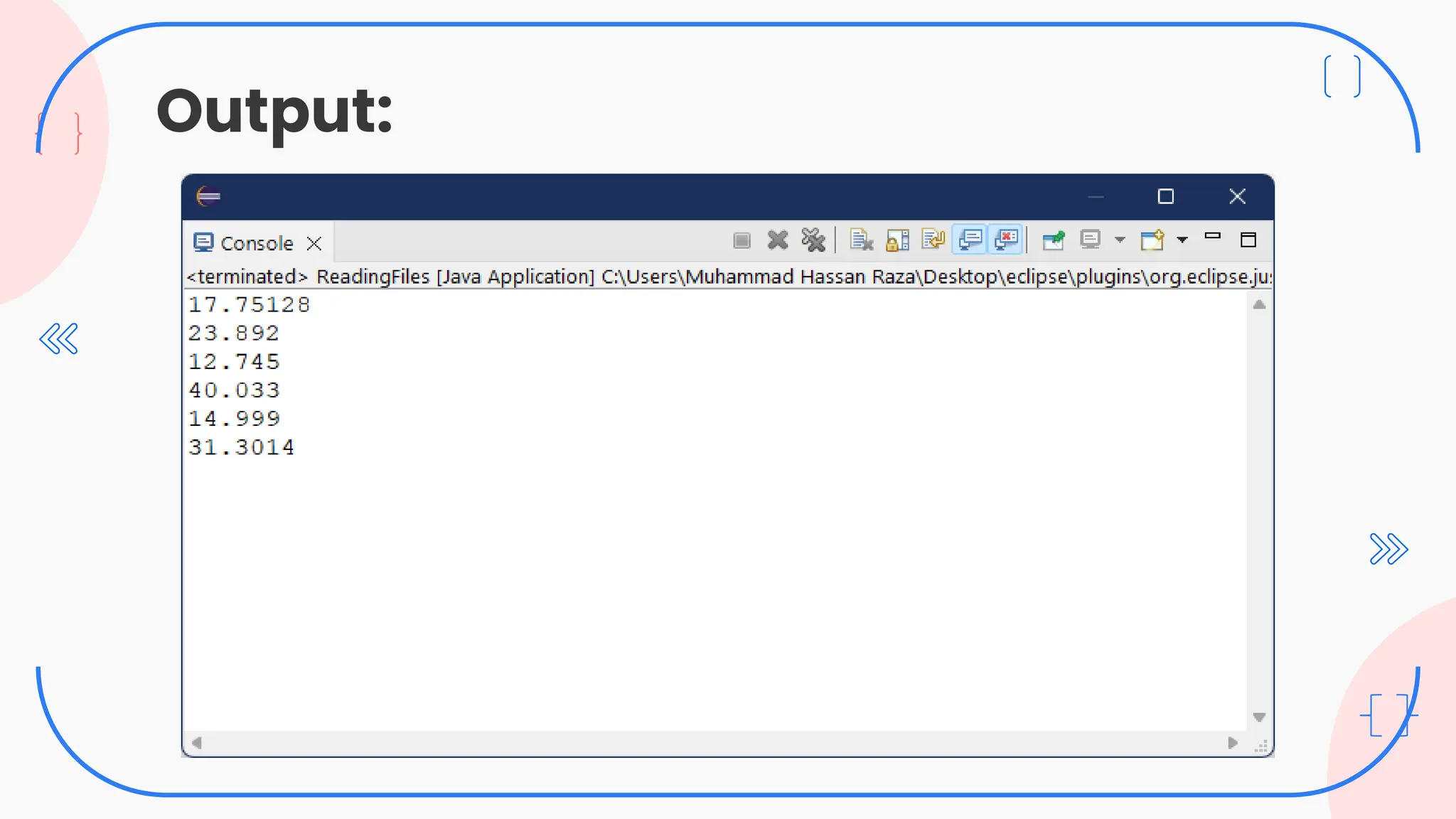
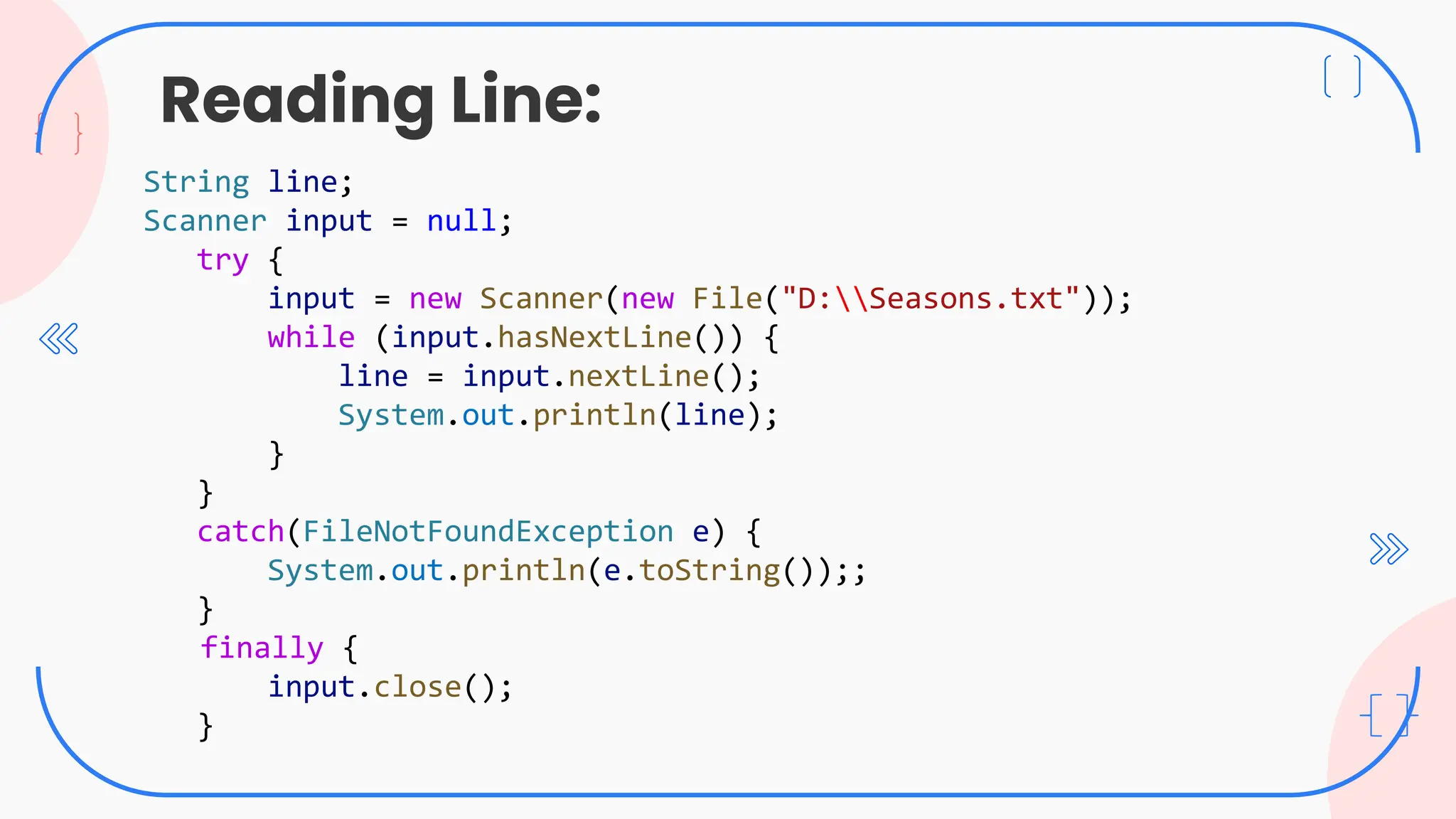

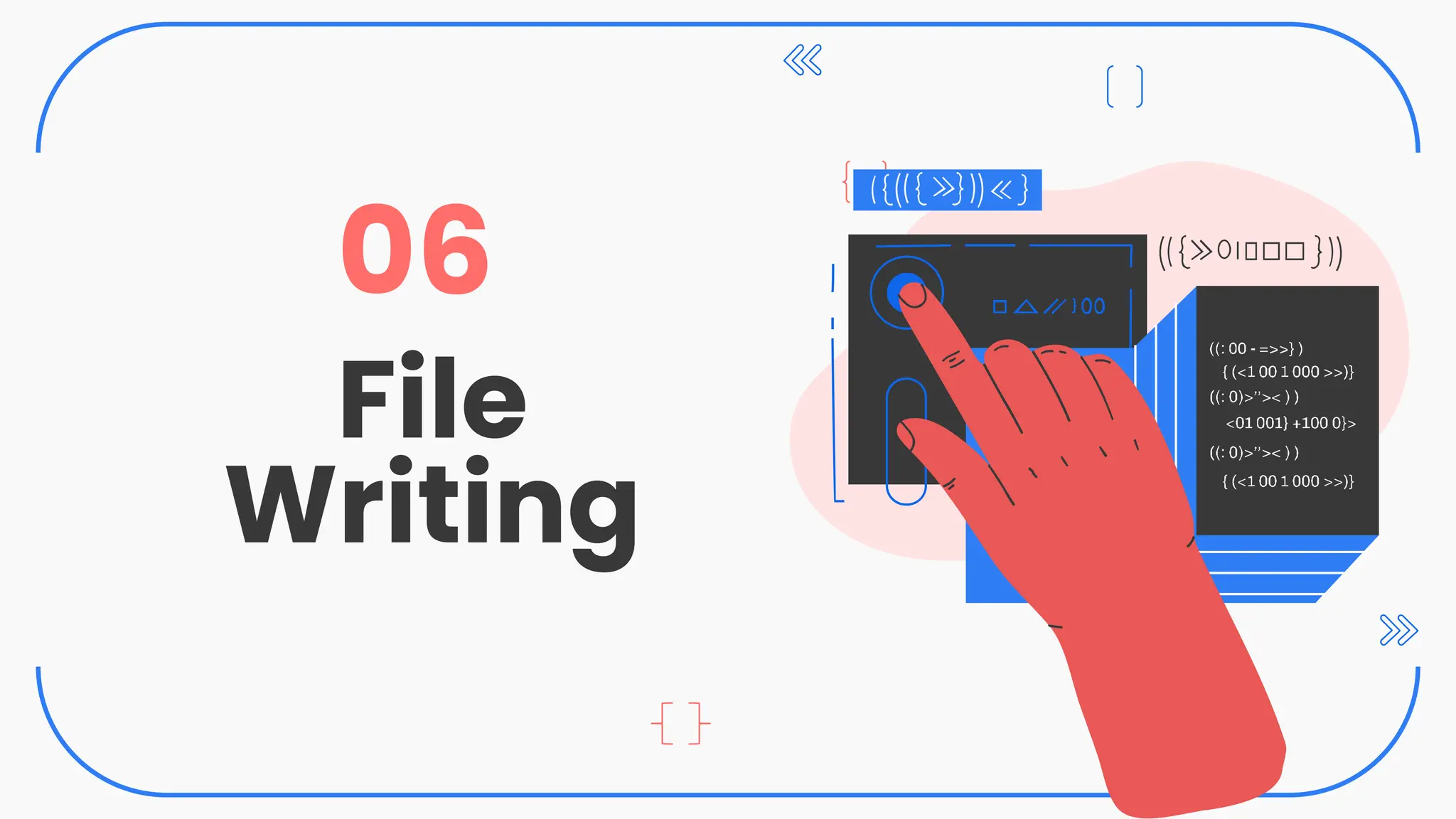
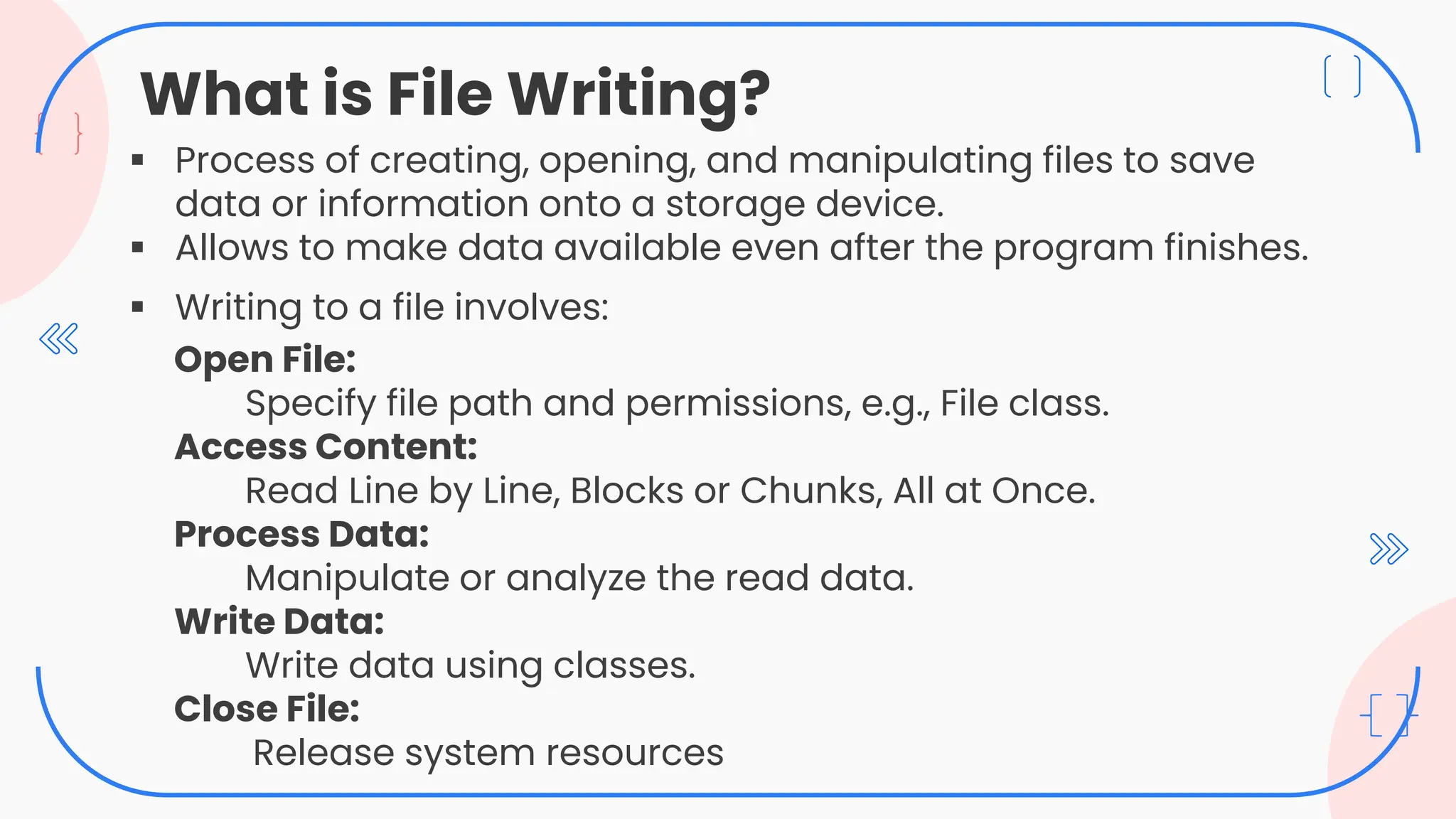
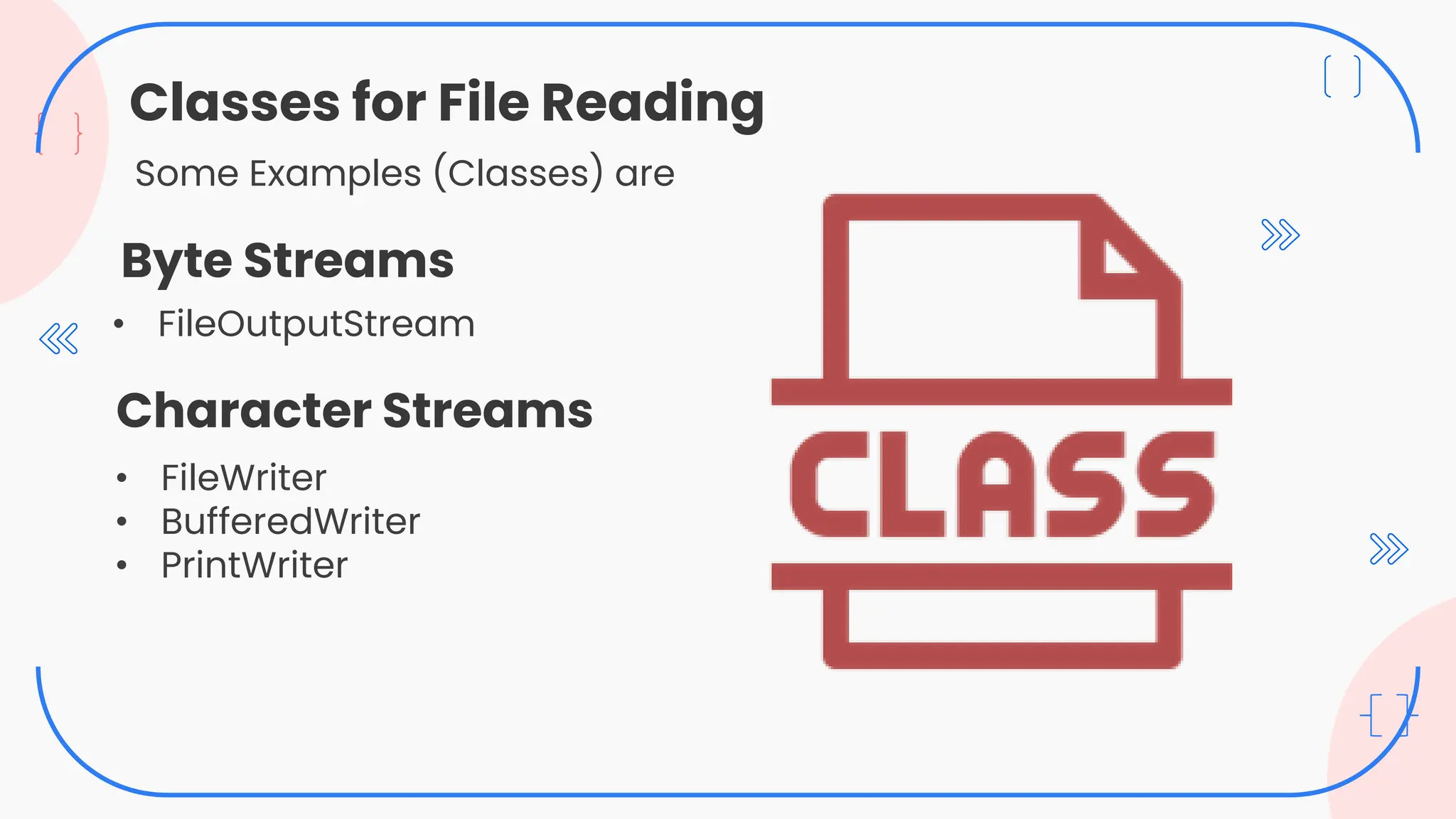
![File Writer
Powerful tool for writing character-based data to files
Designed to work with text files containing letters,
punctuation, and other standard characters.
Offers methods like write, write(char ch), write(char[]
charArr), write(String str),to write characters, arrays of
characters, strings.
Uses an internal buffer to store data efficiently before
writing it to the file.
One can flush the buffer manually using flush() to ensure
data is written immediately
Import FileWriter from java.io package before using](https://image.slidesharecdn.com/filehandling-240514034330-842c4808/75/File-Handlingb-in-java-A-brief-presentation-on-file-handling-46-2048.jpg)
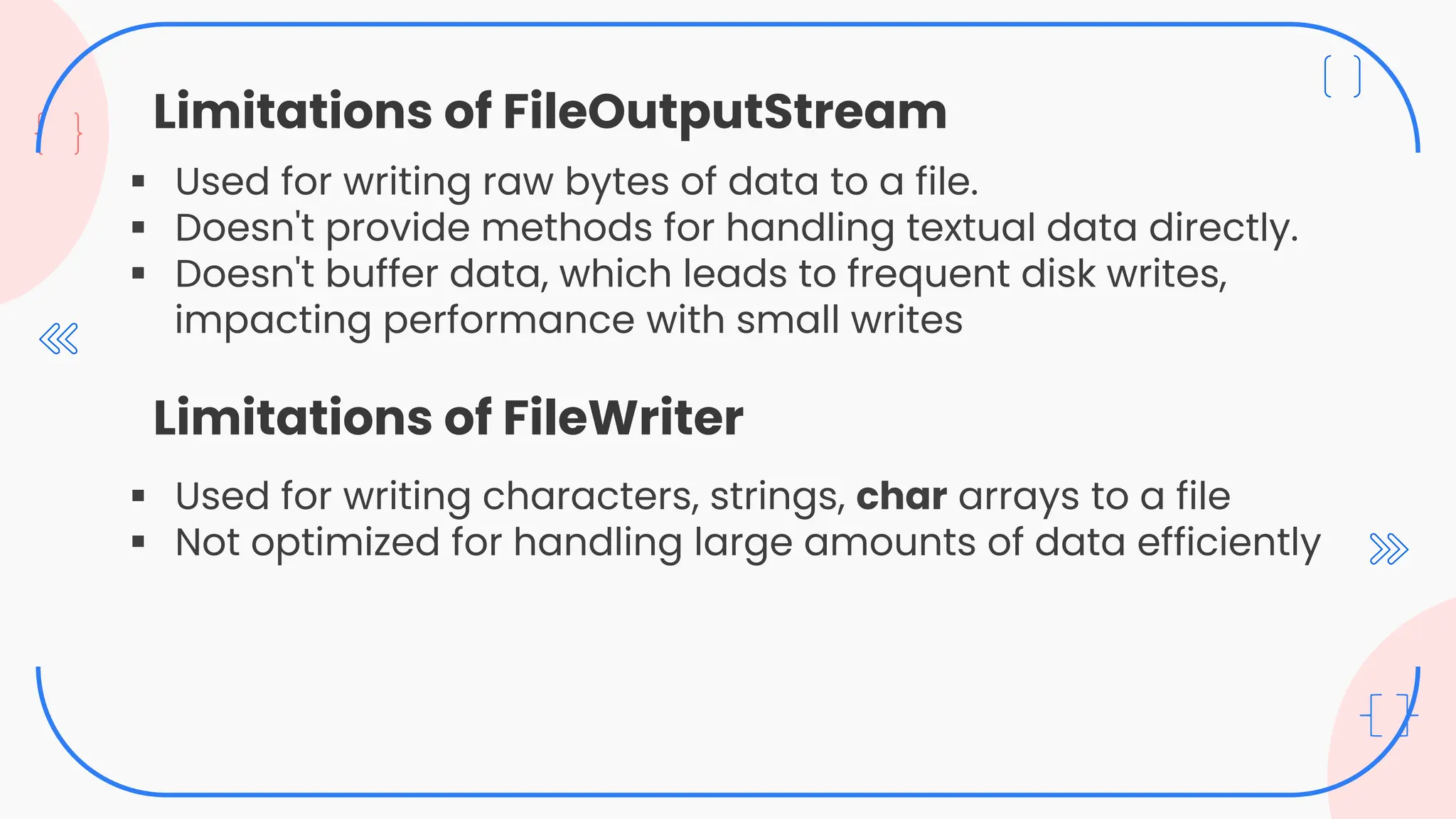
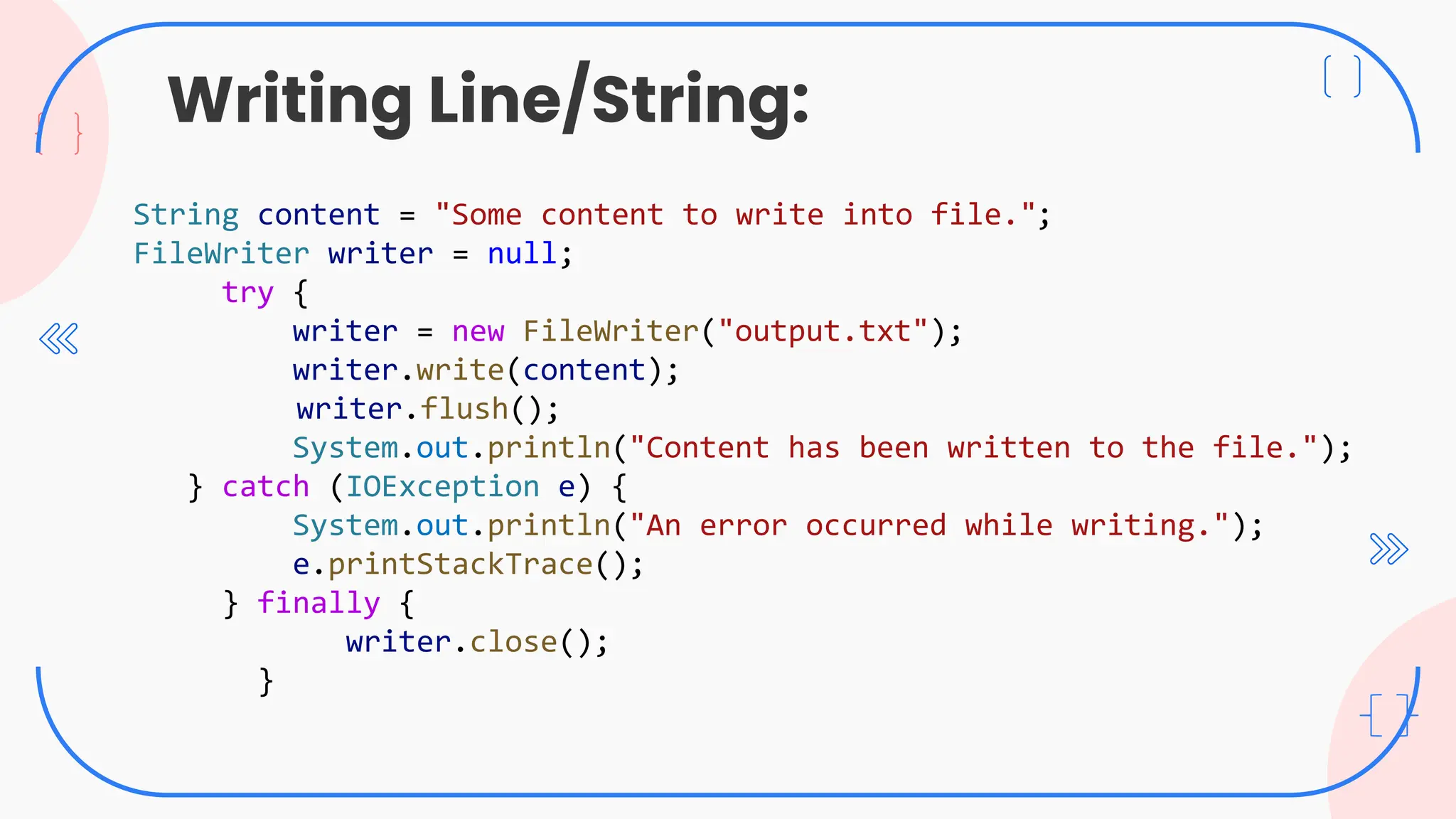

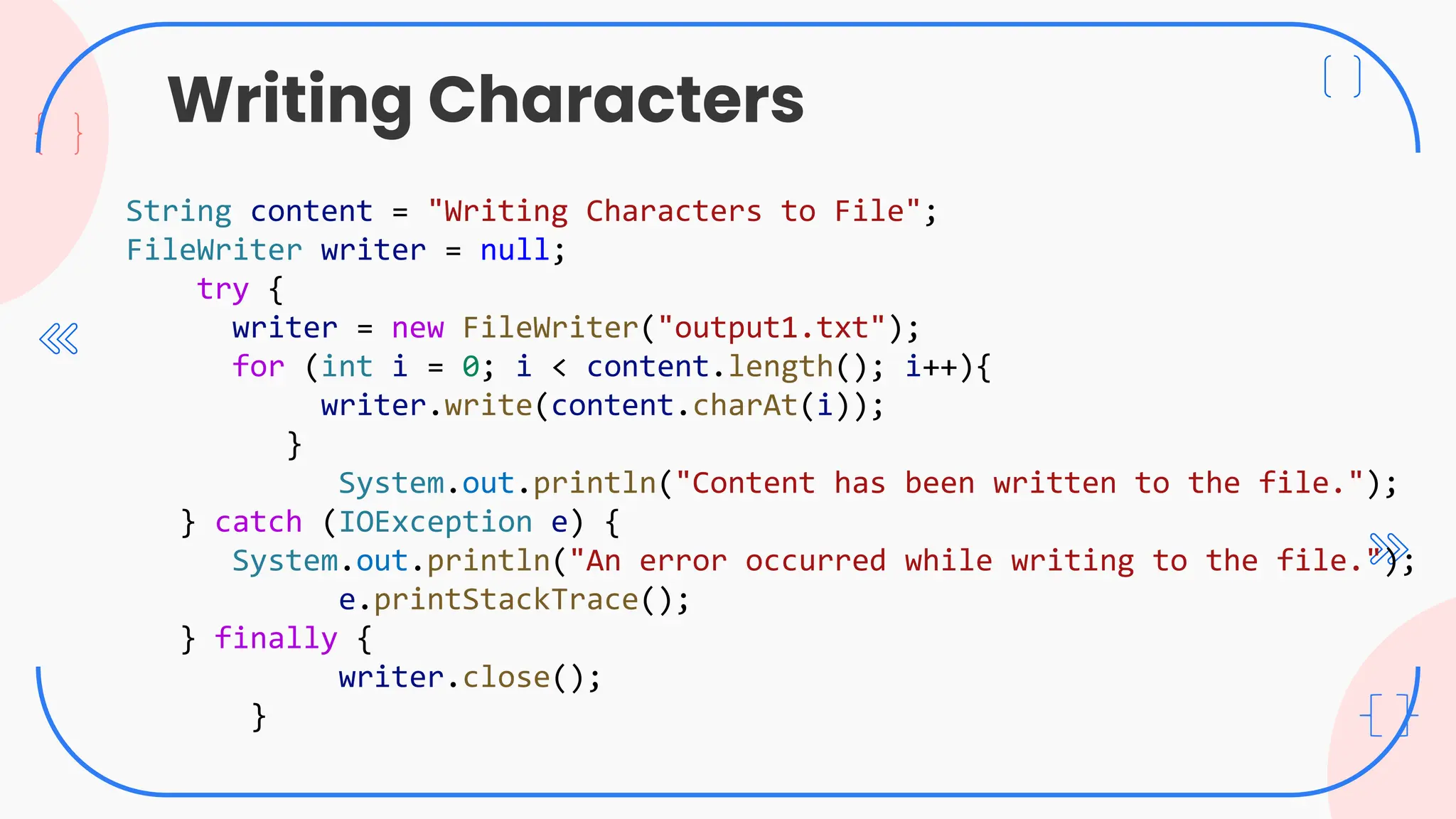
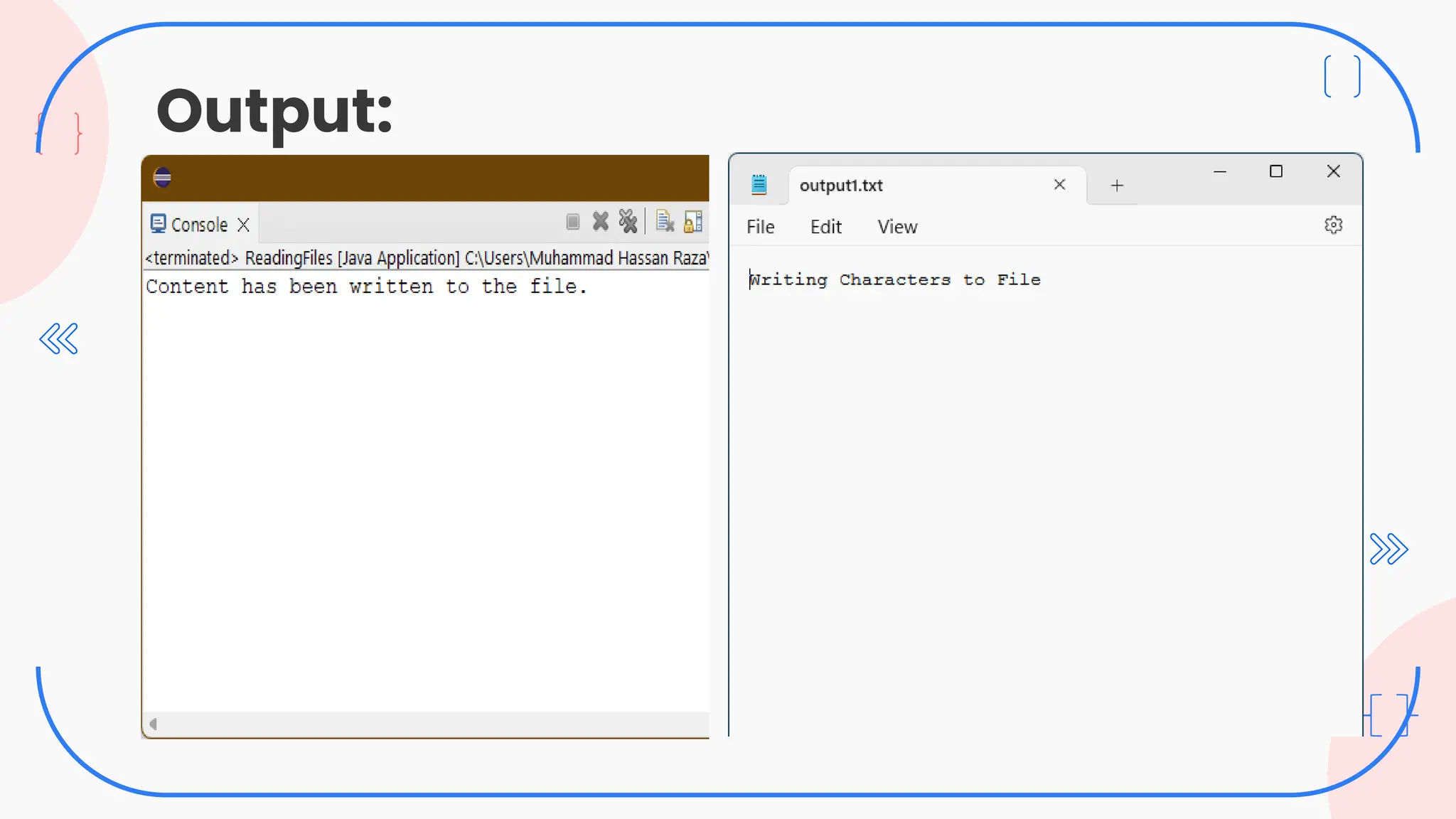
![Writing Character Array
FileWriter writer = null;
try {
char[] charArray = { 'J', 'a', 'v', 'a', '-', '2', '1' };
writer = new FileWriter("output2.txt");
writer.write(charArray);
writer.flush();
System.out.println("Content has been written to the file.");
} catch (IOException e) {
System.out.println("An error occurred while writing to the
file." + "n" + e.toString());
} finally {
writer.close();
}](https://image.slidesharecdn.com/filehandling-240514034330-842c4808/75/File-Handlingb-in-java-A-brief-presentation-on-file-handling-52-2048.jpg)

![Buffered Writer
Powerful tool for writing text to files more efficiently than the
basic FileWriter.
Works by buffering data in memory before writing it to the
underlying file stream.
This can significantly improve performance, especially
when dealing with small files or frequent writes.
Offers methods like write, write(char ch), write(char[]
charArr), write(String str),to write characters, arrays of
characters, strings.
One can flush the buffer manually using flush() to ensure
data is written immediately
Import BufferedWriter from java.io package before using](https://image.slidesharecdn.com/filehandling-240514034330-842c4808/75/File-Handlingb-in-java-A-brief-presentation-on-file-handling-54-2048.jpg)

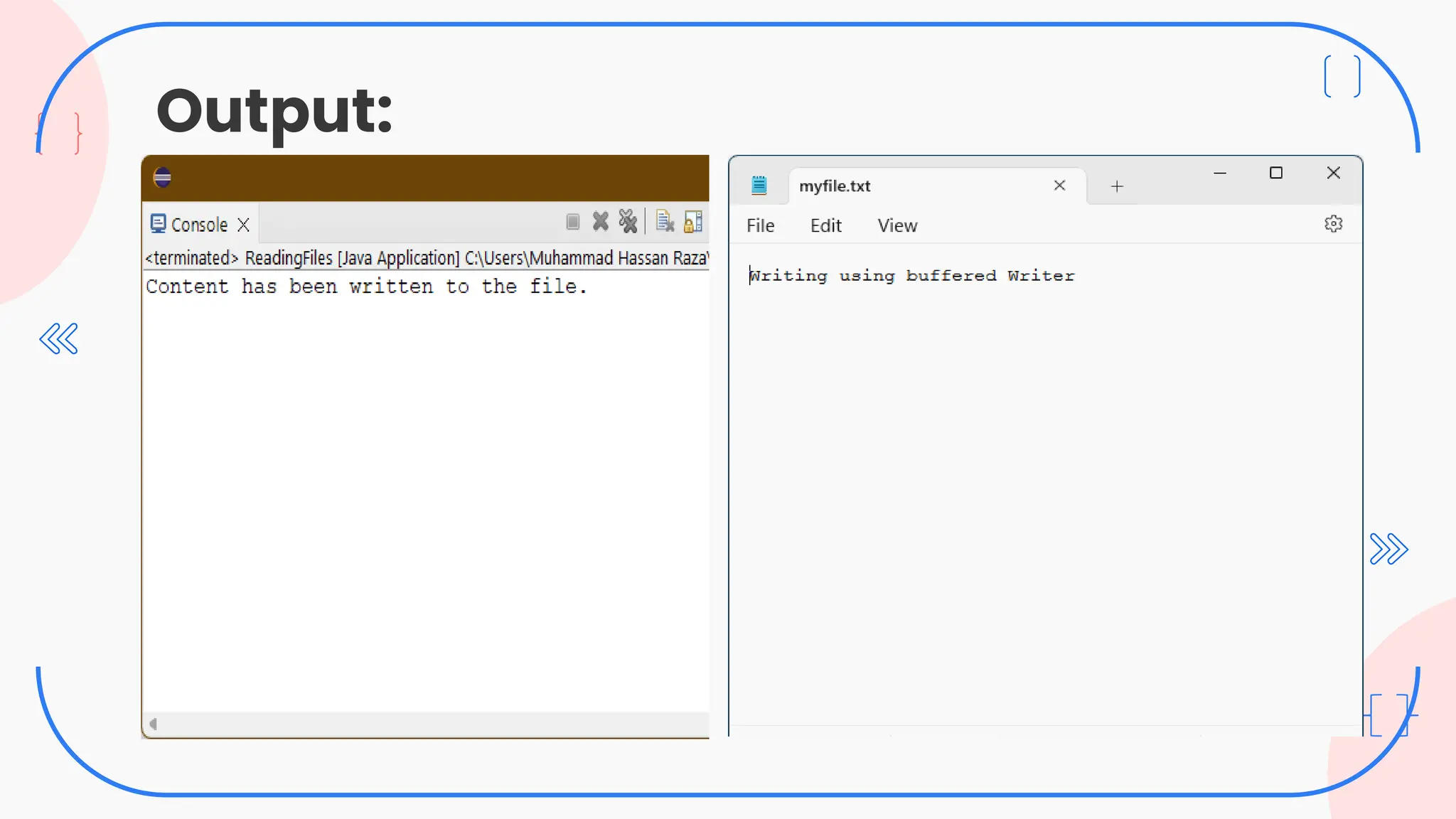
![ Same syntax and procedure as that of FileWriter.
Use these write(char ch), write(char[] charArr).
Writing Character and Char Array:
When to use BufferedWriter?
Consider using BufferedWriter whenever you need to:
Write large amounts of character data to files.
Improve the performance of file writes, especially for small
files or frequent writes.
Enhance the stability and reliability of your file handling](https://image.slidesharecdn.com/filehandling-240514034330-842c4808/75/File-Handlingb-in-java-A-brief-presentation-on-file-handling-57-2048.jpg)
